Last Updated on February 14, 2025 by Owen McGab Enaohwo
![Learning and Development [What It Means + How to Implement It]](https://www.sweetprocess.com/wp-content/uploads/2025/02/learning-and-development.jpg)
Are you investing enough in your team’s growth? With US training expenditures reaching new heights, it’s clear that learning and development (L&D) are top priorities for businesses.
According to Statista, training expenditures in the United States have soared to an impressive $98 billion from 2012 to 2024. But it’s not just about the dollars spent. Did you know that 70% of workers say learning improves their sense of connection to the workplace?
This is not just a statistic from the LinkedIn Workplace Learning Report 2024 but a powerful insight into employee engagement.
Implementing effective L&D programs can be challenging, but this is where SweetProcess comes into play. It’s an invaluable tool that can help simplify your L&D processes, ensuring you get that competitive edge.
In this guide, we’ll discuss what L&D means for businesses and how to effectively implement it to boost your team’s morale and productivity. Stay tuned for actionable strategies and insights!
What You’ll Learn In This Guide:
Understanding Learning and Development: What It Means for Your Business
Why Learning and Development Is Important for an Organization
How to Create an Effective Learning and Development Strategy for Your Business
How to Manage Your Organization’s Learning and Development With SweetProcess
Tools for Effective Learning and Development
Factors Influencing the Success of L&D Strategies
The Future of Learning and Development
Transform Your Learning and Development Program With SweetProcess
Understanding Learning and Development: What It Means for Your Business

Learning and development (L&D) is a strategic HR initiative to strengthen employee growth, enhance skills, and contribute to organizational success.
At its core, it refers to giving your team the tools and knowledge they need to thrive, whether through effective onboarding, upskilling programs, or mentorship opportunities. Take AI, for example. As technology evolves, many companies are rolling out courses to help employees stay ahead of the curve.
On top of that, with demographic shifts and a changing workplace culture, L&D programs need to promote inclusivity and support cross-generational collaboration. The pandemic forced businesses to rethink their approach to L&D, with many embracing online learning and virtual mentorship. When you invest in L&D, you’re not just boosting employee engagement but setting your team up for success, driving innovation, and keeping your business competitive in a rapidly changing corporate world.
Why Learning and Development Is Important for an Organization
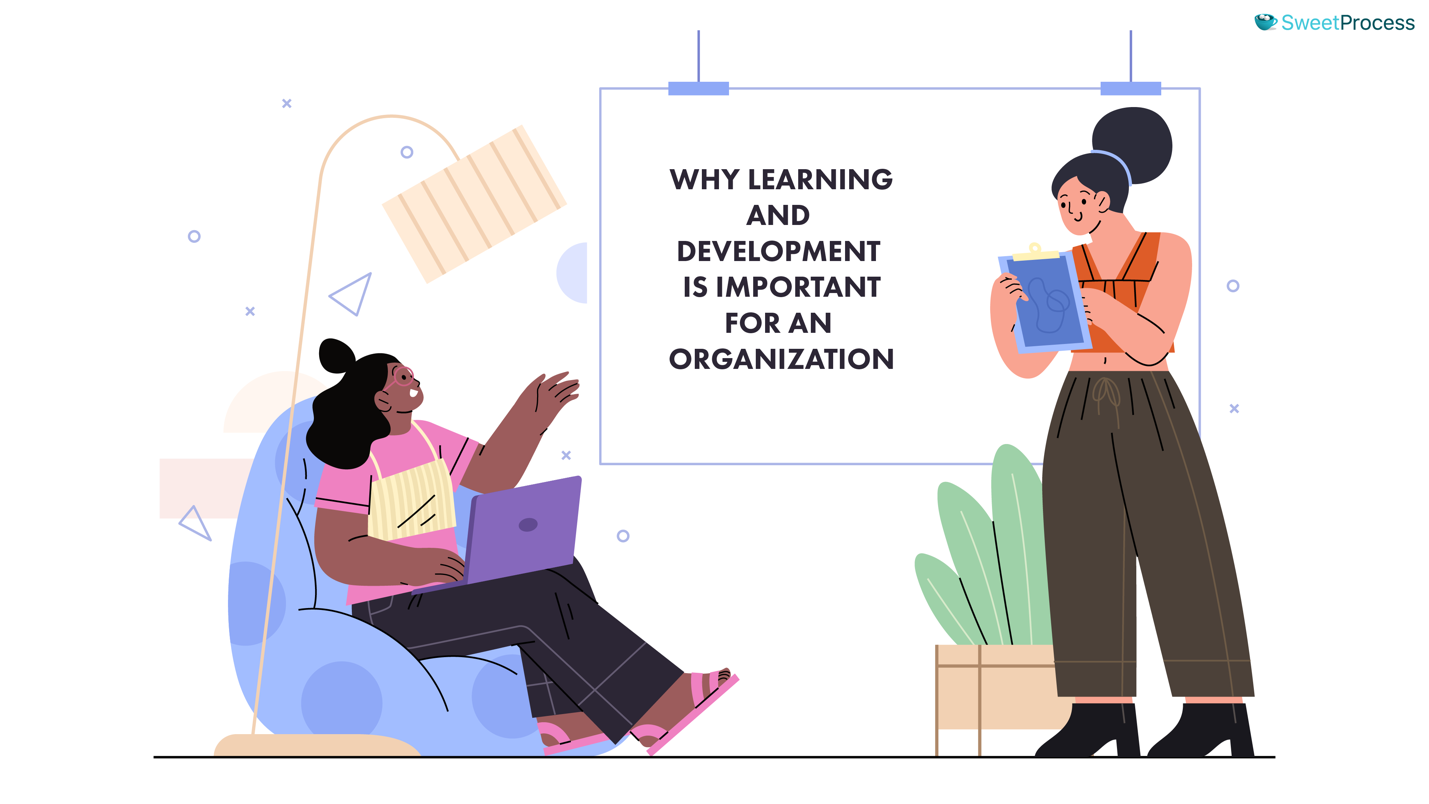
So far, we’ve covered what L&D is and how it’s evolving in today’s workplace. Let’s see why L&D is crucial for your organization’s success.
Improved Employee Performance
Effective L&D programs significantly boost employee performance and engagement. Employees who feel prepared and supported are more likely to excel in their roles. Unfortunately, according to Gallup, only 29% of new hires feel fully prepared after their onboarding experience. This often leads to underperformance and disengagement.
However, those with a clear professional development plan are 3.5 times more likely to find their onboarding exceptional. Early learning opportunities are crucial for setting employees up for success, ensuring they are productive and committed from day one.
Increased Retention and Job Satisfaction
Investing in L&D promotes employee retention and job satisfaction. When employees see growth opportunities, they stay more engaged and loyal. In today’s tight labor market, 75% of companies struggle to fill open positions. Nearly 90% of job seekers also prioritize skill development programs and clear career paths. Consequently, companies with a strong learning culture see 57% higher retention rates, underscoring the value of team development. Therefore, investing in L&D boosts engagement and drives long-term business success by ensuring a loyal, skilled workforce.
Enhanced Organizational Adaptability
The business world is rapidly changing, and adapting is crucial. When businesses prioritize continuous learning, they are better equipped to handle surprises and stay competitive. Effective L&D programs ensure your team is always ready to tackle new challenges and embrace change. Whether it’s the rise of AI or shifting market demands, keeping your employees’ skills up-to-date is non-negotiable. Ultimately, you’ll want to cultivate a culture of growth and flexibility that empowers your workforce and keeps the organization ahead of the curve.
Better Customer Experience
When your employees are educated, happy, and motivated, it directly impacts your customers. Imagine a customer reaching out for support and speaking to an employee who’s knowledgeable and eager to help. That positive interaction leaves the customer feeling valued and more likely to return. According to a Salesforce study, 80% of customers say a company’s experience is just as crucial as its products.
Additionally, 88% say excellent customer service makes them more likely to buy again. In a nutshell, investing in L&D helps ensure your team delivers those memorable experiences every time.
How to Create an Effective Learning and Development Strategy for Your Business
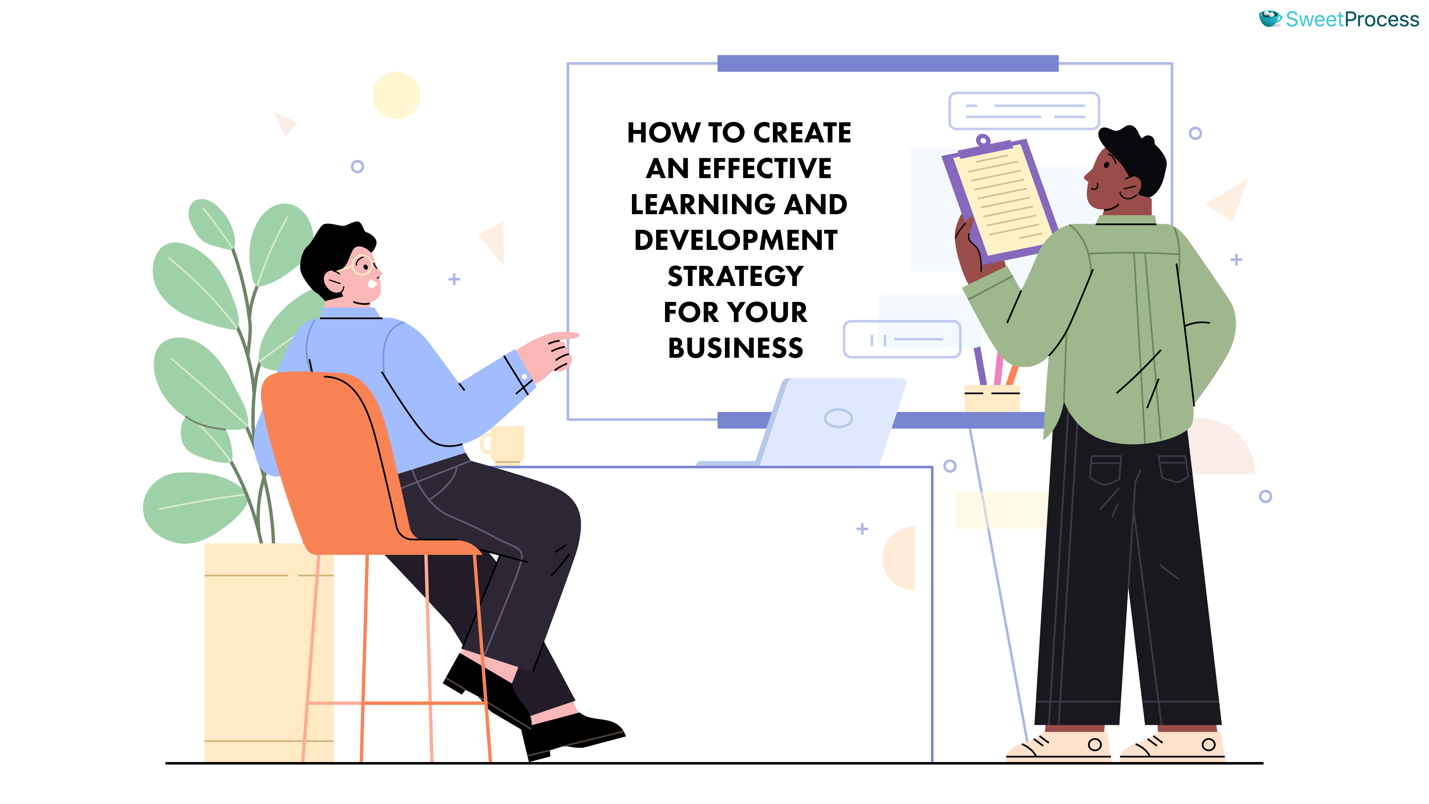
Now that we’ve covered the benefits of L&D, you might wonder how to create an effective strategy for your business. Let’s see how:
Integrate L&D With Business Goals
L&D is crucial for your company’s growth, both now and in the future. Therefore, it must be integral when setting business goals. Let’s say your company is eager to expand but realizes the team lacks the skills needed for success. Without proper training, those goals can easily slip away. Hence, an effective L&D strategy will align your employees’ growth with your business objectives. You’ll start by identifying skill gaps and providing targeted training for team members. This way, you ensure your team is ready to help the company move forward. When L&D and business goals work together, success becomes much more achievable.
Define and Design With Business Leaders
Building on the idea of aligning L&D with business goals, the next step is to bring in key leaders to ensure your strategy is practical and effective. Let’s say your sales team wants to improve their pitching skills. While the L&D team can create training, it won’t be as effective without input from sales leaders who know the team’s specific challenges. This collaborative approach facilitates training that directly addresses the company’s needs and helps drive meaningful results.
Assess Workforce Capabilities and Pinpoint Skill Gaps
After aligning your L&D strategy with business leaders, it’s time to examine your team’s strengths and weaknesses. Imagine a small real estate company where the team excels at closing deals but struggles with digital marketing. Skill assessment can help spot these gaps and focus your training efforts where needed. Whether mastering new tech tools or improving leadership skills, identifying these areas enables you to tailor an L&D plan that keeps the business competitive.
Design Tailored Learning Pathways
Next, you’ll want to design tailored learning pathways for your team. For instance, an auditing company where junior auditors must master advanced analytics while senior staff can benefit from leadership training. Personalized learning plans ensure each team member gets the relevant training they need.
Take a cue from Apple’s strategy, which emphasizes self-reliance in professional development. This approach addresses individual growth and aligns with the company’s goals. This way, everyone grows together, driving personal and organizational success.
Execute Learning and Development Programs
Once everything is in place, executing your learning and development strategy is next. This is where your strategy truly comes to life and starts making a difference. Start with onboarding for new hires, then introduce upskilling training sessions for current employees. Keep the momentum going with regular training and updates. Remember, execution is key to turning plans into results, so make sure your L&D programs are engaging, relevant, and continuous.
Monitor Progress and Measure Outcomes
After launching your learning and development programs, the next step is monitoring progress and measuring outcomes. In L&D, tracking employee progress and gathering feedback is essential. You’ll want to use tools like skill assessments and performance reviews to see what’s working. These include Google Analytics, 15Five, TalentLMS, SurveyMonkey, and BambooHR. With these, you can adjust your strategy, ensuring business growth.
Evaluate Impact and Refine Approaches
Lastly, evaluate the impact and refine your approach. This is akin to running a fitness program; you wouldn’t just track your workouts — you’d assess overall health improvements and tweak your routine for better results. Similarly, in L&D, the data is analyzed, and feedback is gathered. Use this information to fine-tune your strategy, ensuring continuous improvement and maximum impact on your employees and business goals. This final step ensures that your L&D initiatives remain relevant and practical.
How to Manage Your Organization’s Learning and Development With SweetProcess
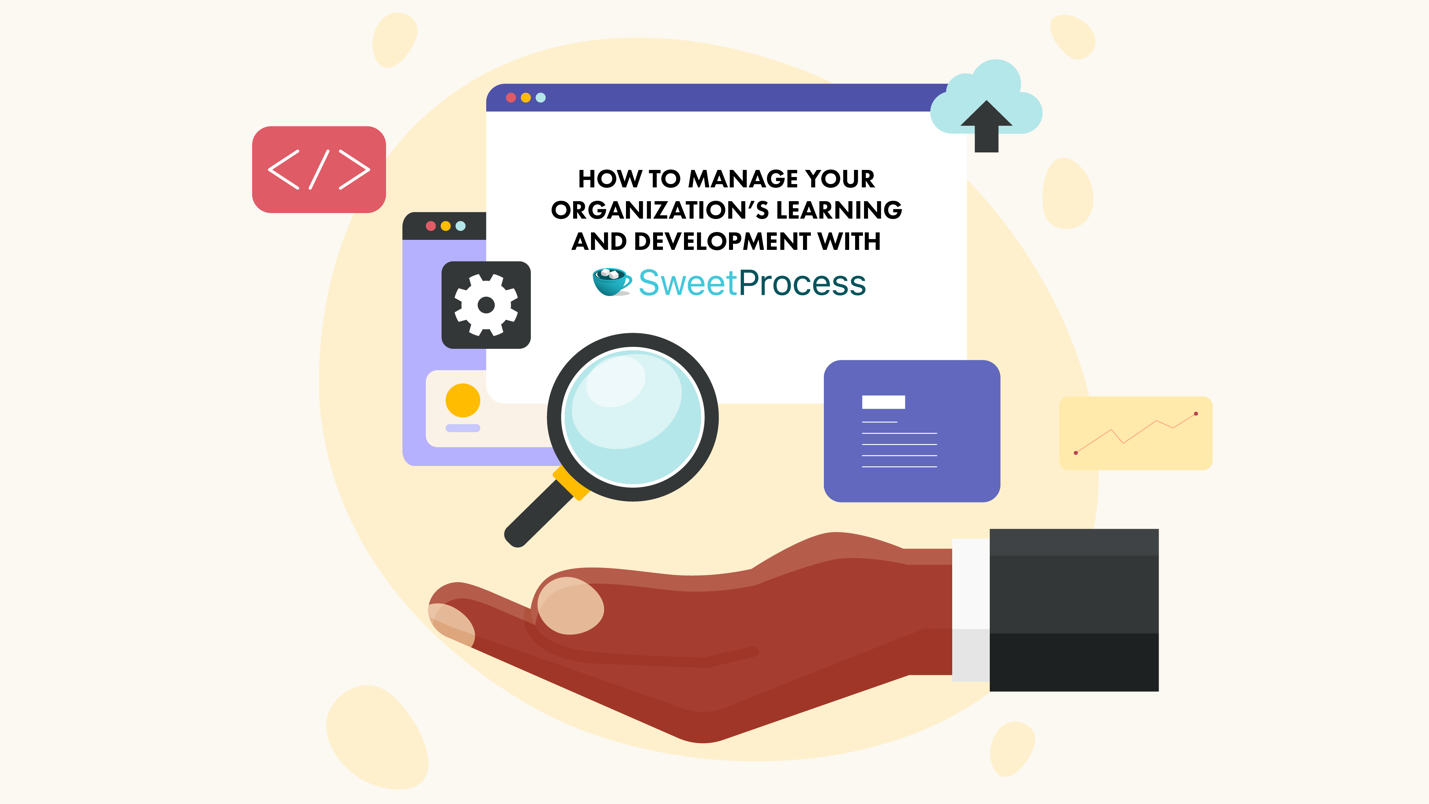
This section uncovers how SweetProcess can simplify managing your organization’s learning and development.
Build a Quiz to Assess Your Team’s Grasp of Company Policies, Processes, and Procedures
Creating quizzes is an excellent way for businesses to ensure employees understand essential company policies, processes, and procedures. This not only reinforces learning intervention but also identifies knowledge gaps that can be addressed with further training. With SweetProcess, building a quiz is simple and efficient.
Steps to Build a Quiz in SweetProcess
1) Navigate to Quizzes
- From the dashboard/Documents page, click the “More” button.
- Select “Quizzes” from the drop-down menu.
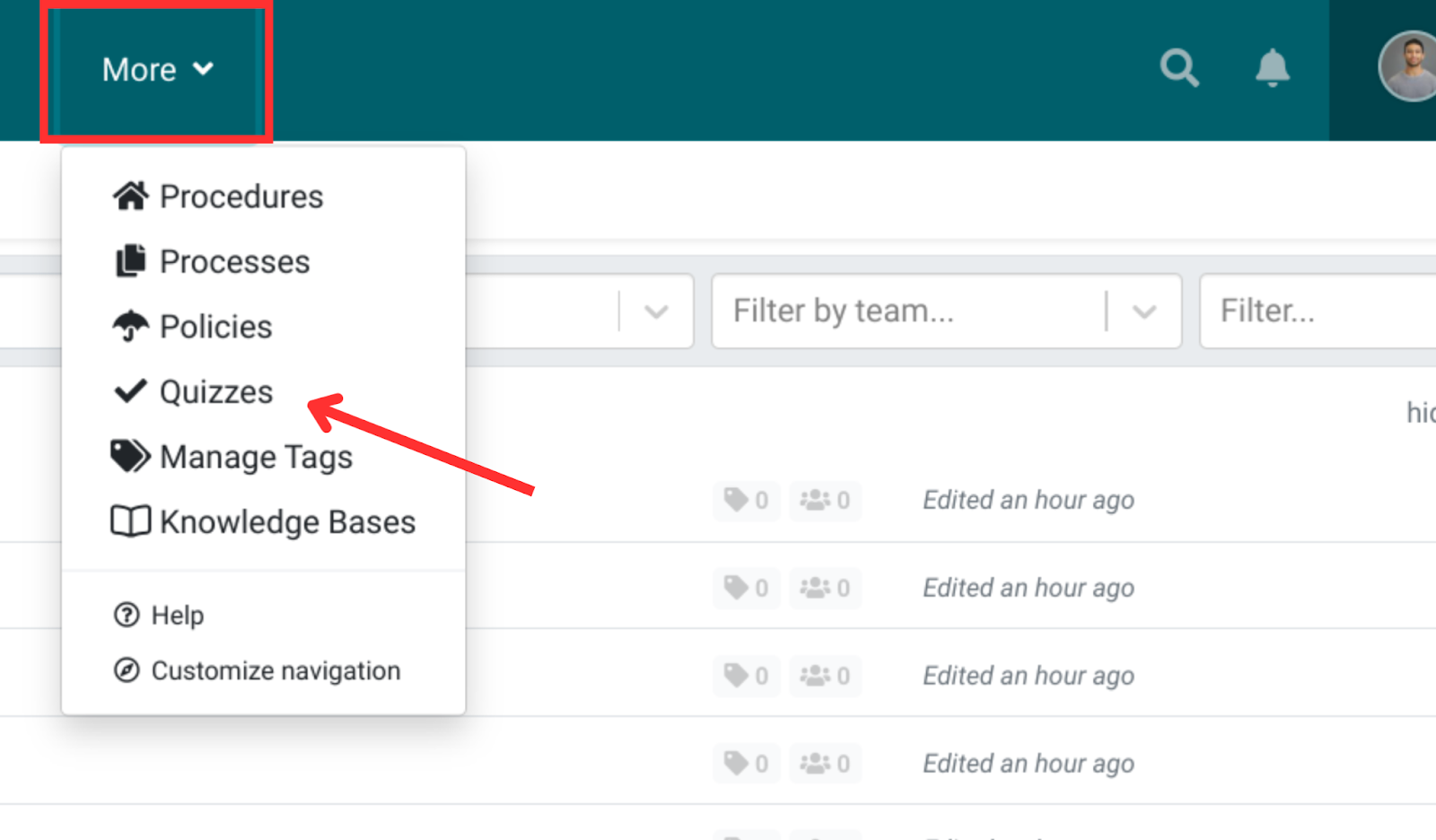
2) Create a New Quiz
- In the new window, click the “Create a new quiz” button.
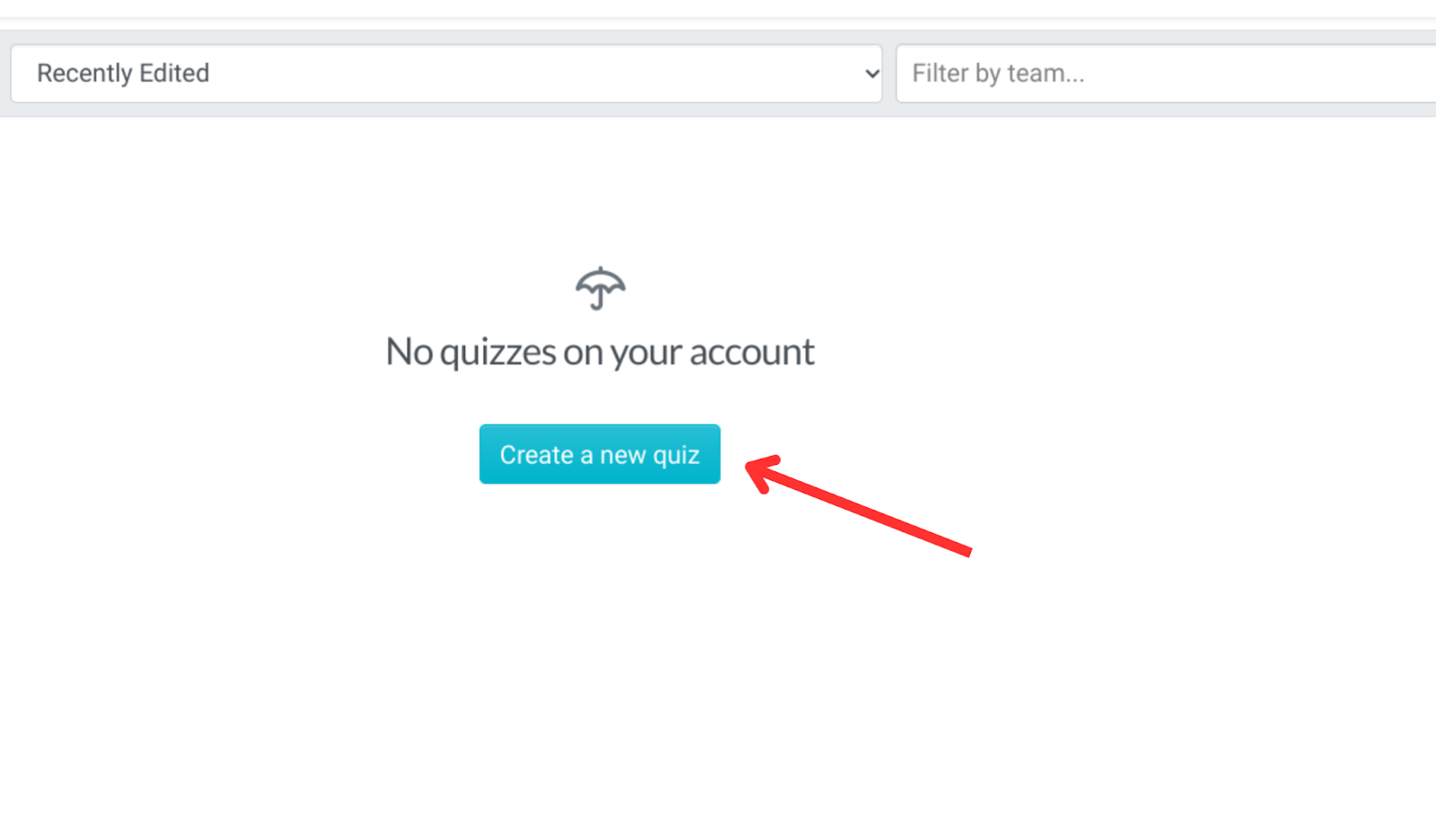
- Enter a title for your quiz. For this example, we’ll call it “Company Protocols: How Well Do You Know Them?”
- Click “Continue” to proceed.

3) Add Questions
- Click the “Add Question” button at the bottom of the screen.
- Choose between multiple-choice answers or open-ended answers. For this example, select multiple choice.
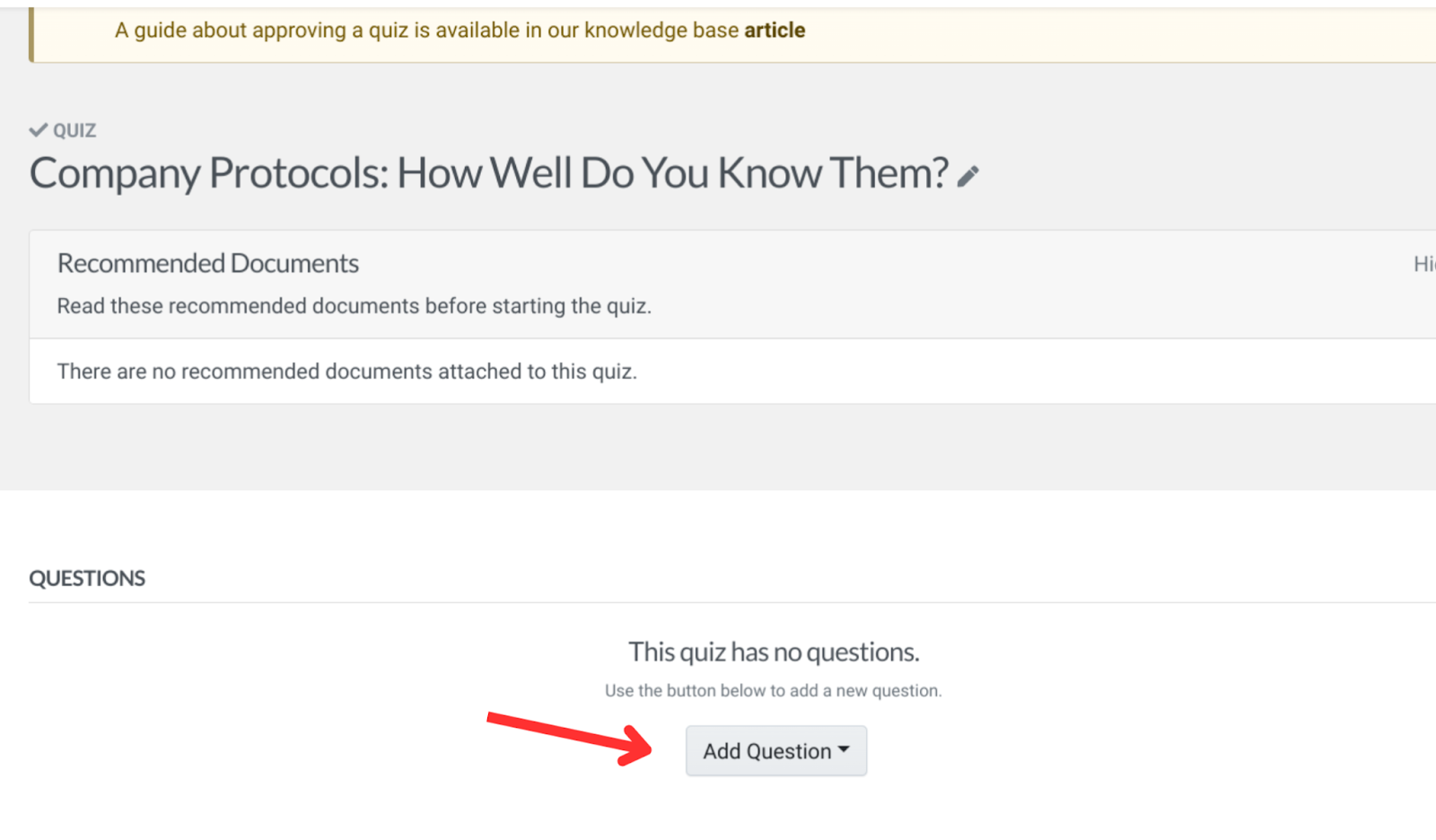
- On the next screen, add your questions and multiple-choice answers. Tick the correct answer as shown.
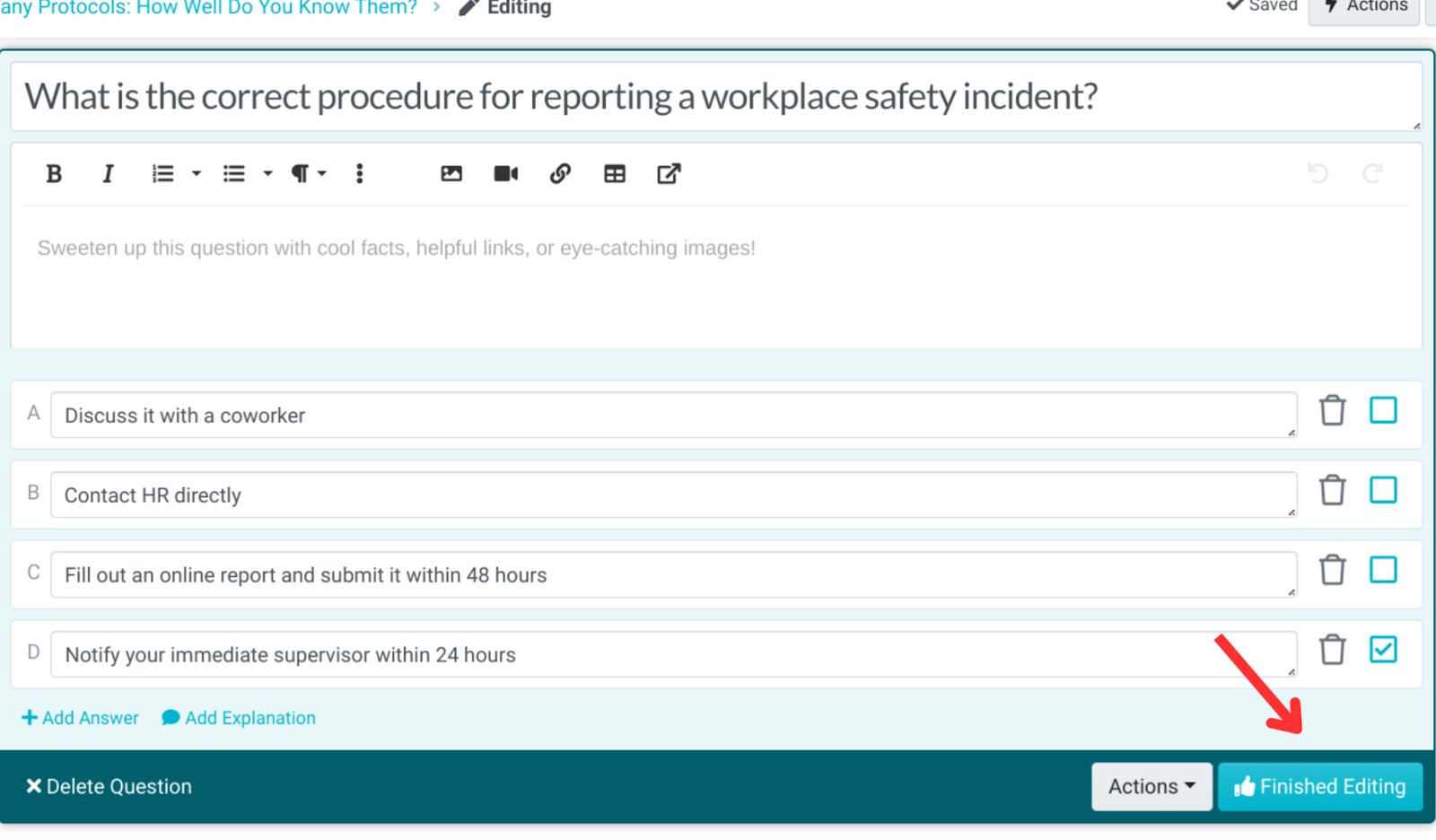
4) Finish and Approve
- When everything looks great, click “Finished Editing.”
- Repeat the process to add more questions to your quiz.
- Once satisfied, click “Approve” at the top of the screen.

And that’s it—you’ve created a comprehensive quiz for your team!
Quizzes are an excellent way to ensure your team stays well-informed and aligned with company policies. For example, IMS ExpertServices used quizzes to identify knowledge gaps and enhance their onboarding process, leading to improved performance and a more knowledgeable team. This proactive approach can strengthen your company’s L&D efforts, making your training more effective and efficient.
Document Repetitive Tasks in One Place
Documenting repetitive tasks is crucial for L&D because it ensures consistency, reduces errors, and helps employees learn standard procedures quickly.
By capturing key processes in SweetProcess, you make it easier for employees to follow the same steps each time, creating efficiency and minimizing confusion. It also serves as a powerful training tool for new hires, helping them ramp up faster and stay aligned with company standards.
Steps to Create a Procedure in SweetProcess
1. Navigate to Procedures
- From your dashboard, click the “More” button.
- Select “Procedures” from the drop-down menu.

2. Create a New Procedure
- On the new page, find your previous procedures, but to create a new one, click the “Create Procedure” button at the top right.
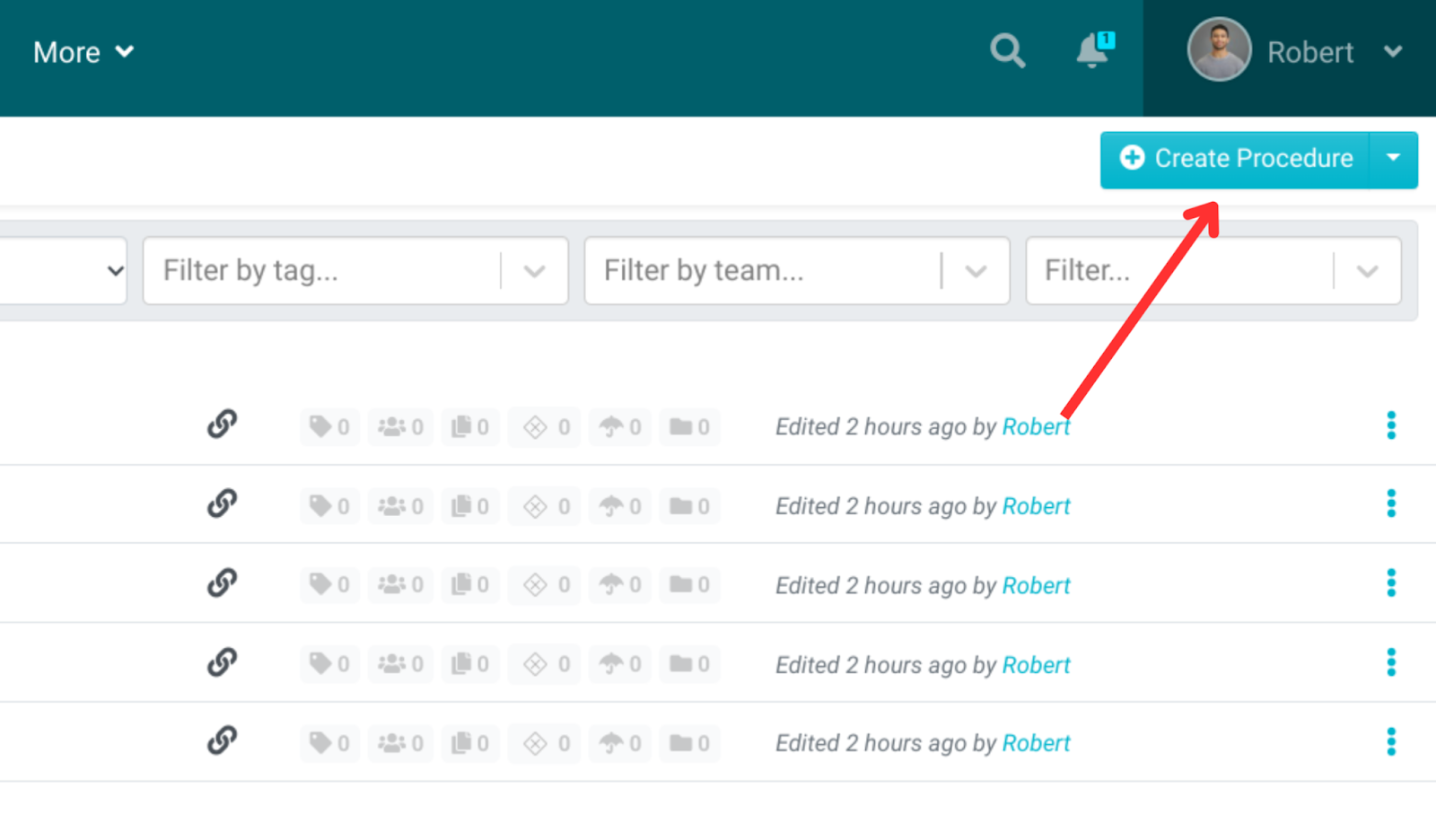
3. Add a Title
- Enter a title for your procedure. For example, “Employee Onboarding and Orientation.”
- Click “Continue” to proceed.
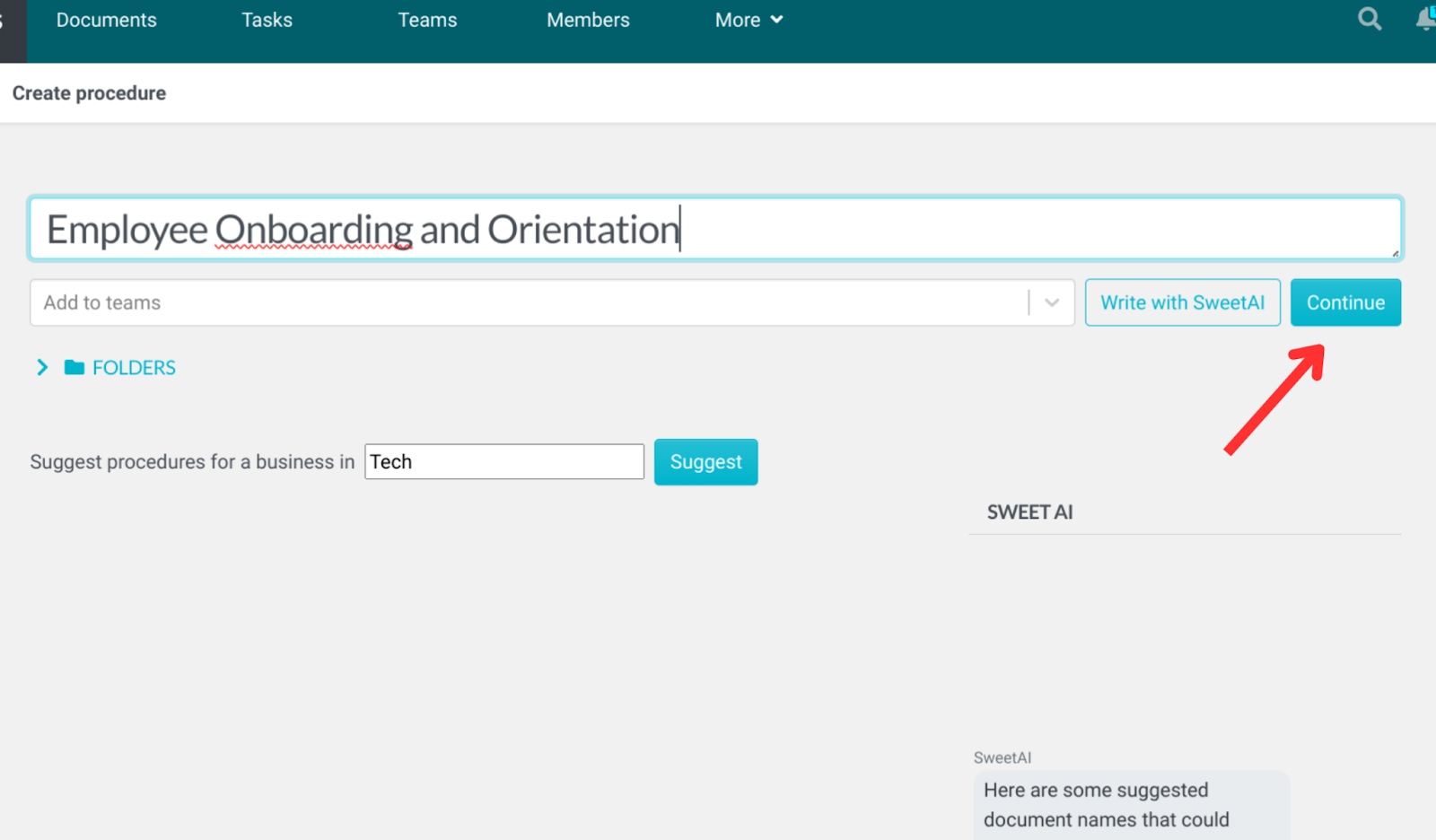
4. Add Steps
- Click the “Step” button and enter the title and details for each step of the procedure.
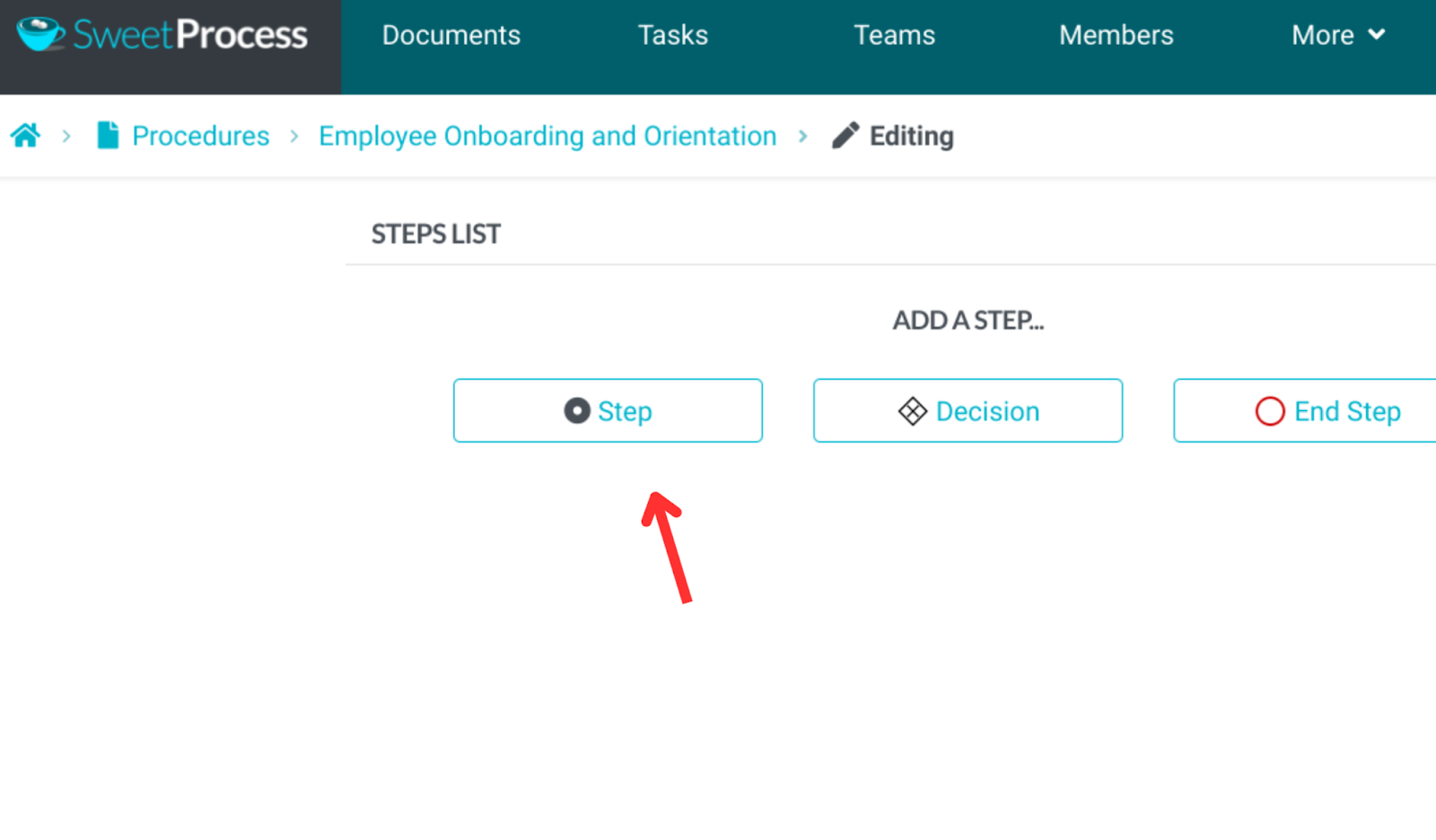
- Add details to the step.
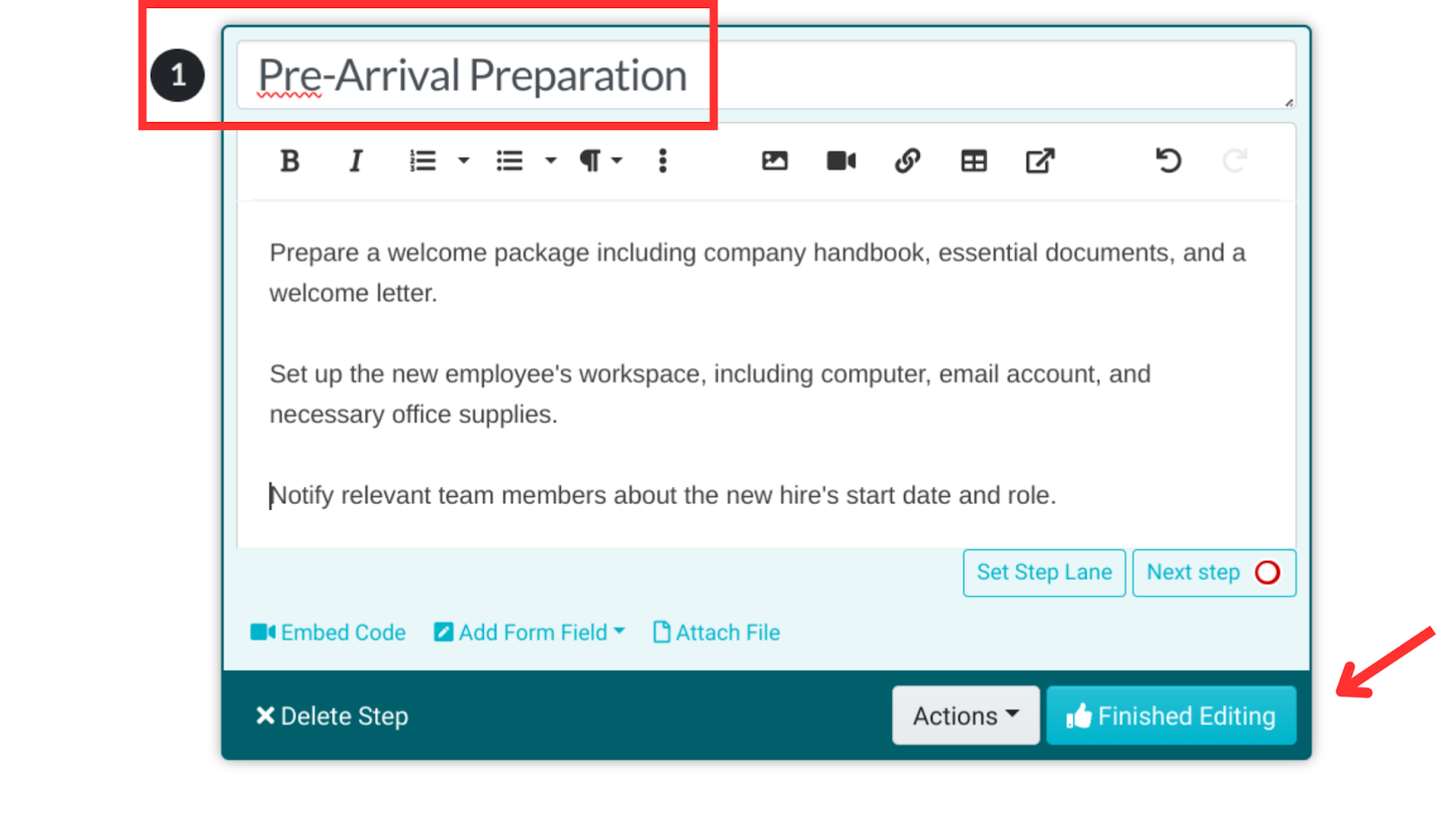
- Once everything looks perfect, click “Finished Editing.”
- Repeat this for all necessary steps.
5. After adding all the steps, click “Approve” to finish.
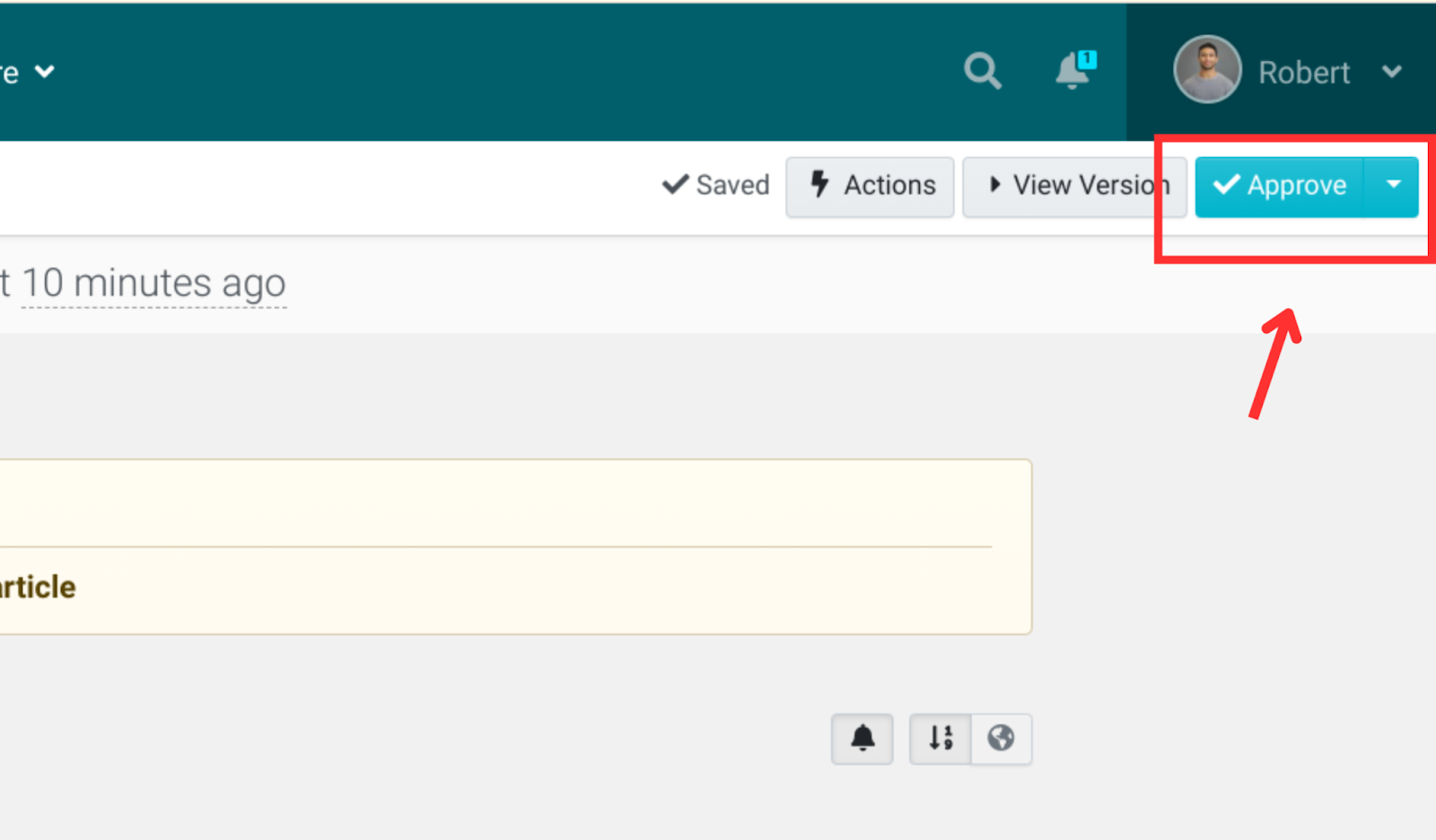
And just like that, you’ve successfully created a procedure in SweetProcess. Now, you can assign it as a task to teams in your organization to ensure a simplified, repeatable process!
Set Up Your Teams to Reflect Your Company Culture
Setting up teams within your company is essential for encouraging collaboration and aligning L&D efforts with your company culture. Effective team organization streamlines communication, promotes teamwork, and ensures everyone is on the same page with training and learning objective. Here’s a step-by-step guide to set up teams in SweetProcess:
1) Navigate to Teams
- From the home screen, click on “Teams” in the navigation bar.
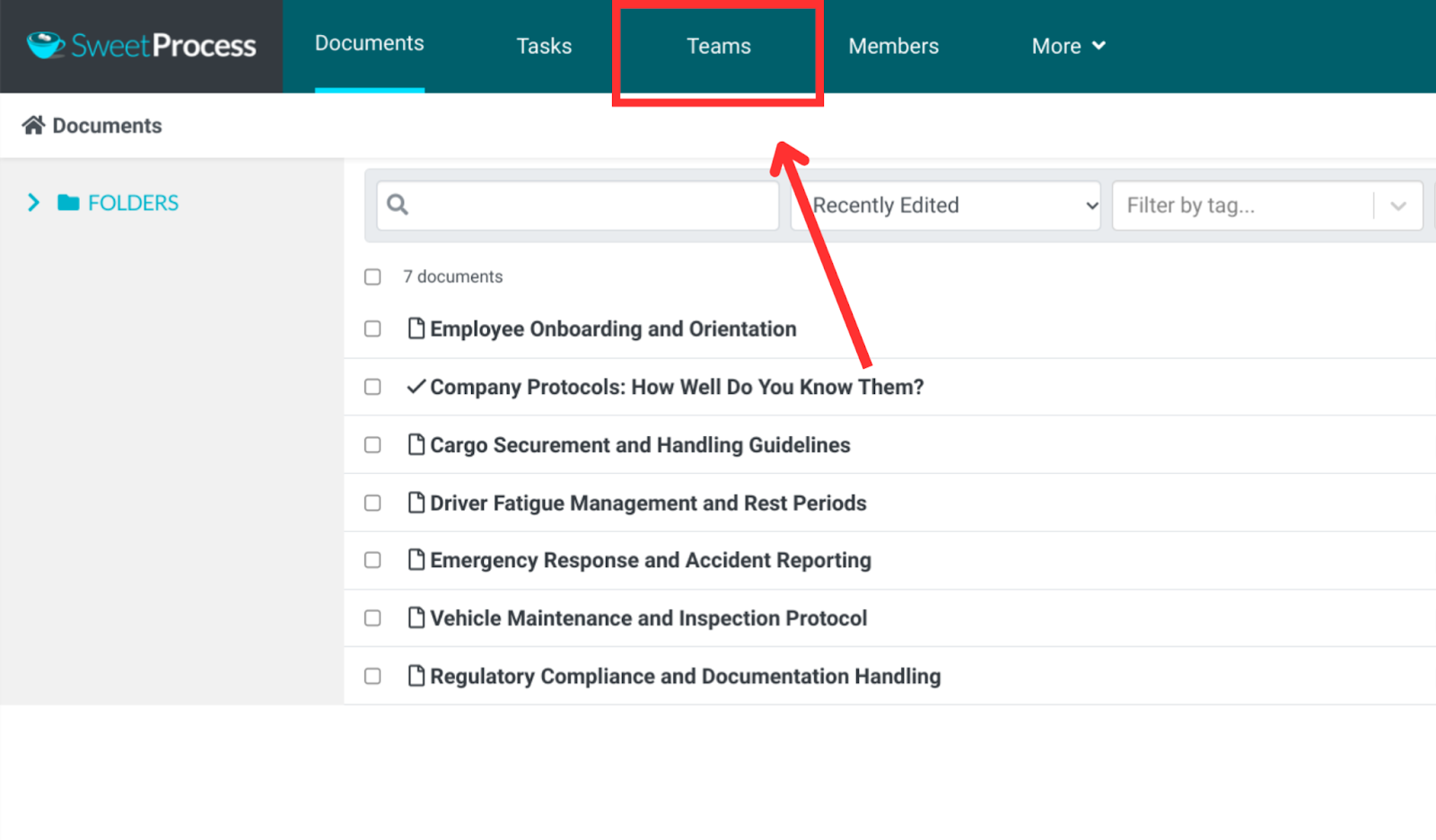
- Select “Create a new team” or “Create Team” on the resulting screen.
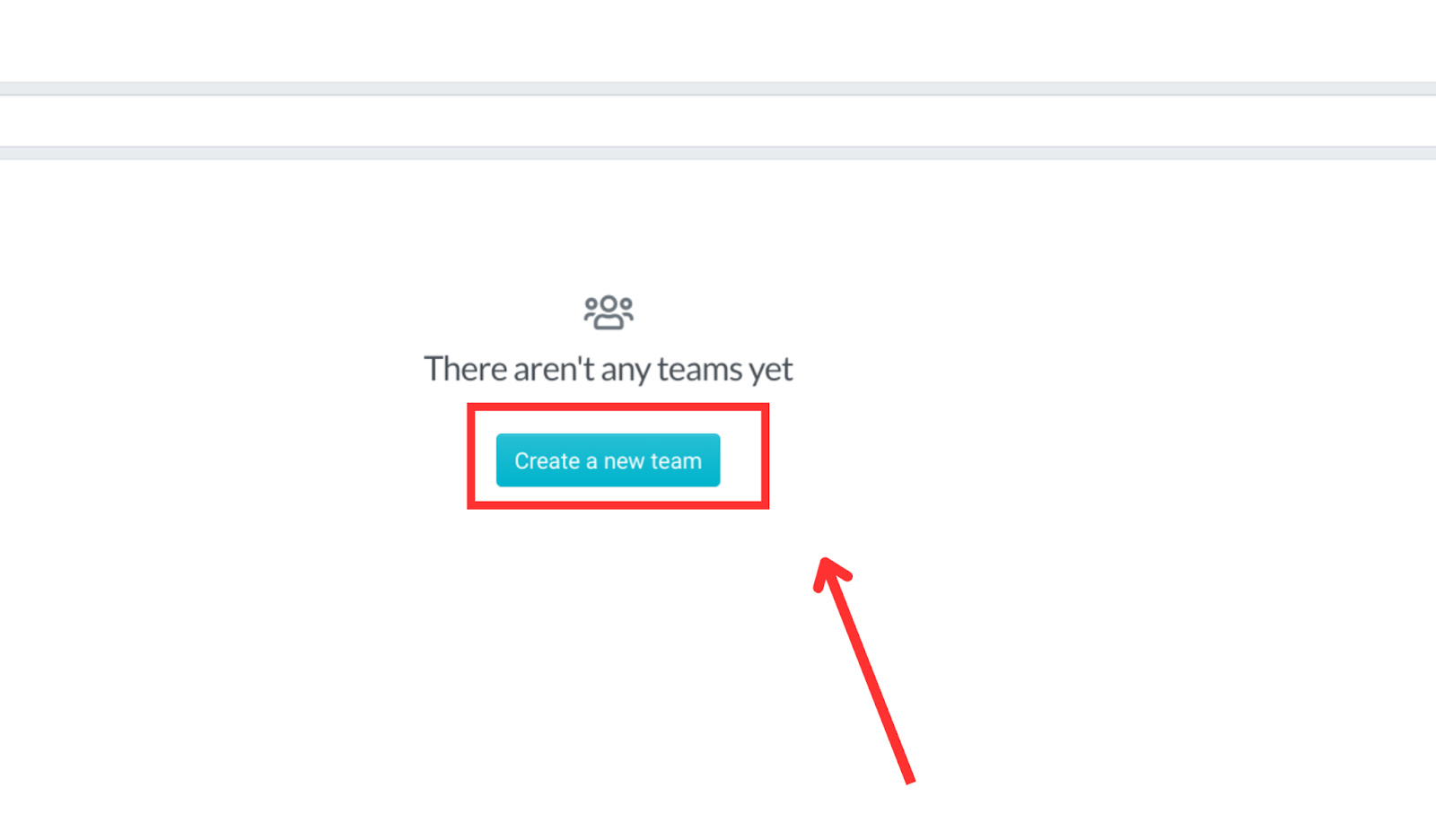
2) Add Team Details
- In the new window, give your team a title, such as “Sales and Marketing Team.”
- Add a short description if needed.
- Click “Create Team.”
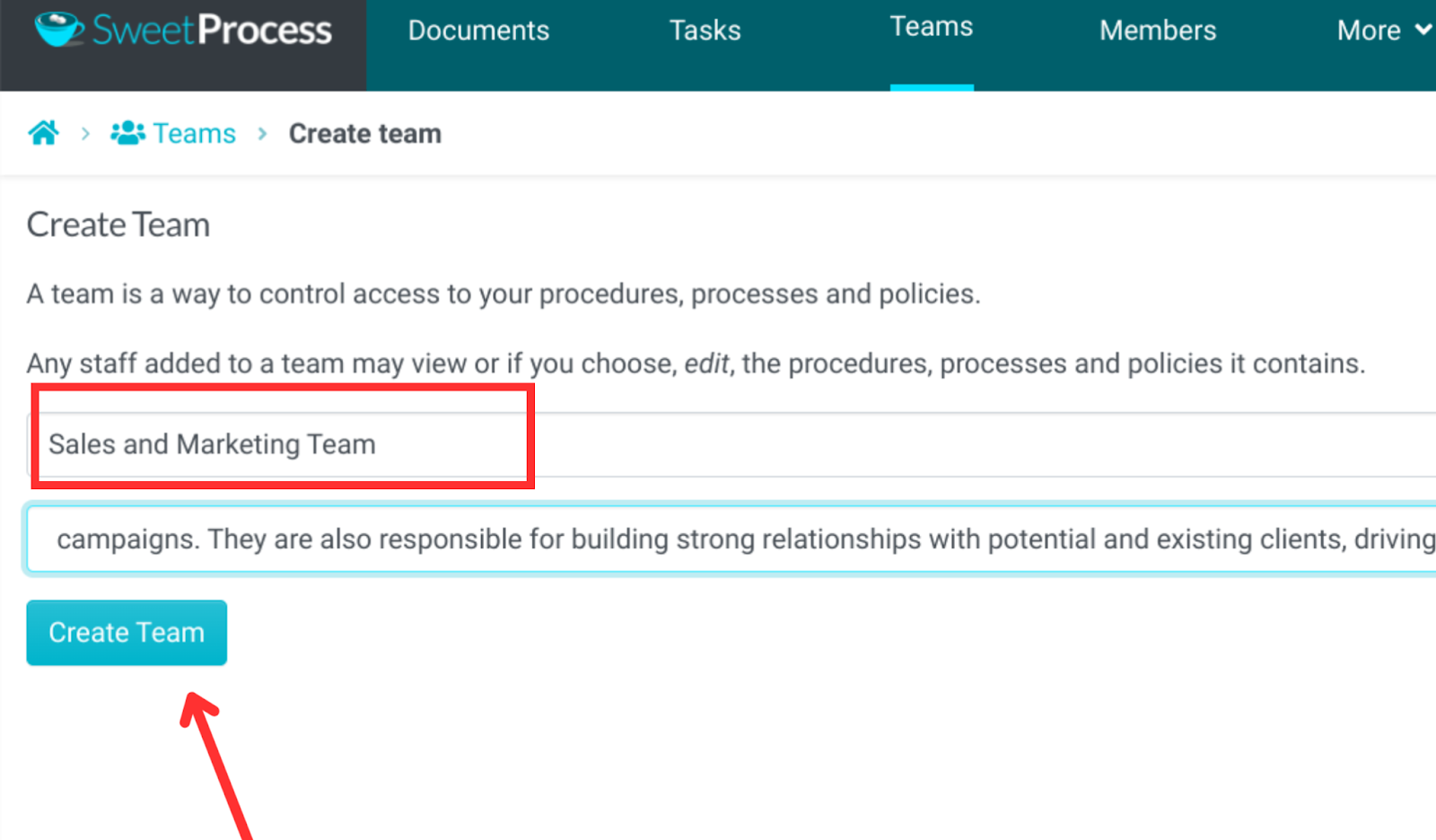
3) Add Team Members
- Click the “+Member” button.
- Select employees in your company to join this team or invite new employees.
- Once you have all your members, click “Confirm” to finalize.
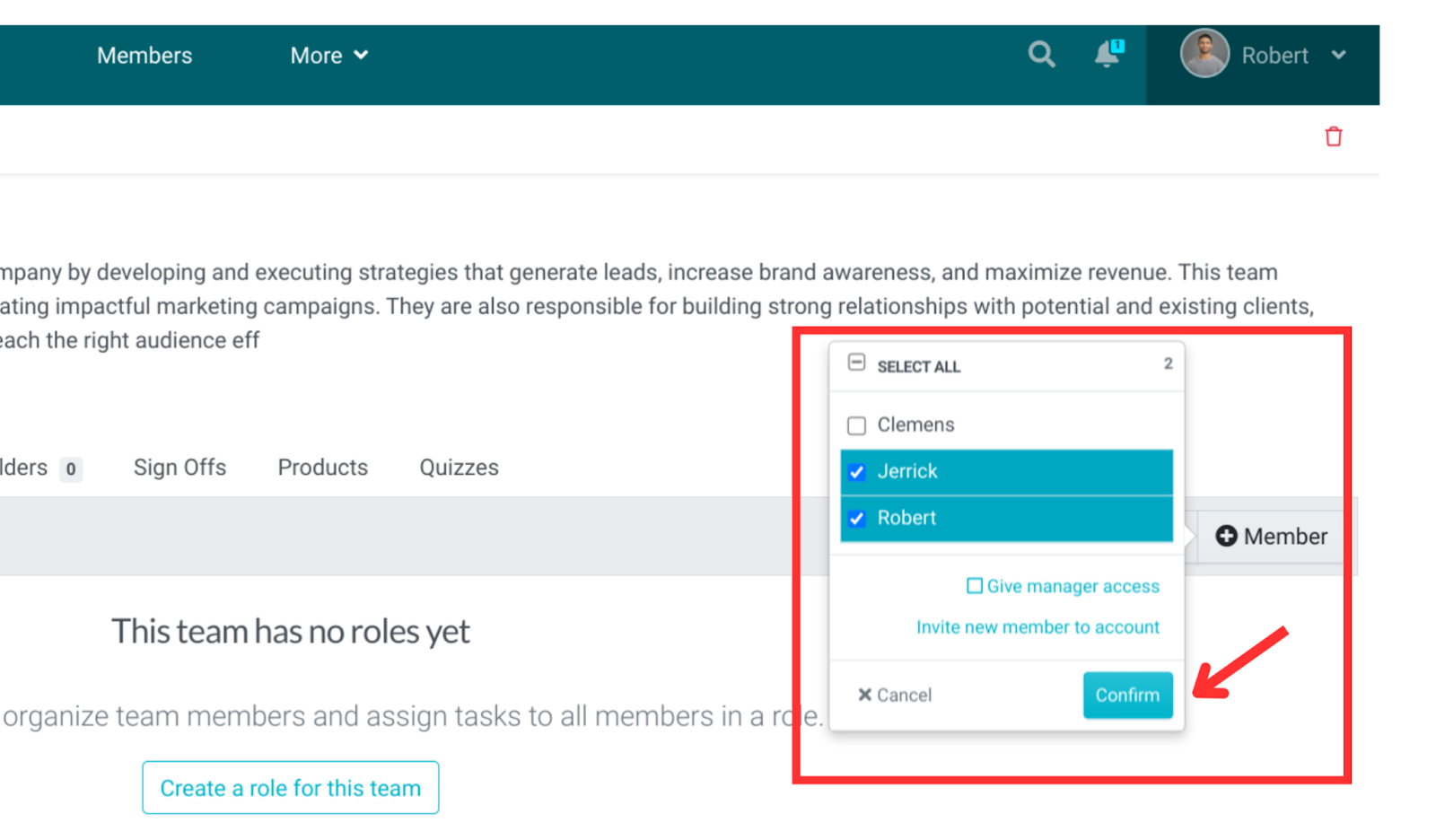
And that’s it! Your team has been successfully created. All invited team members will be notified via email, ensuring everyone is aware and can start collaborating immediately.
Turn Procedures and Processes Into Actionable Tasks
Turning procedures and processes into actionable tasks ensures your team members can easily follow and complete essential workflows. Here’s how to do this using SweetProcess:
1) Navigate to Procedures
- From your home screen, click the “More” button.
- Select “Procedures” from the drop-down menu.
2) Select the Procedure to Assign
- On the new screen, find the procedure you want to assign as a task.
- Click on the three dots in front of the selected procedure.
- Choose “Assign as Task” from the side menu.
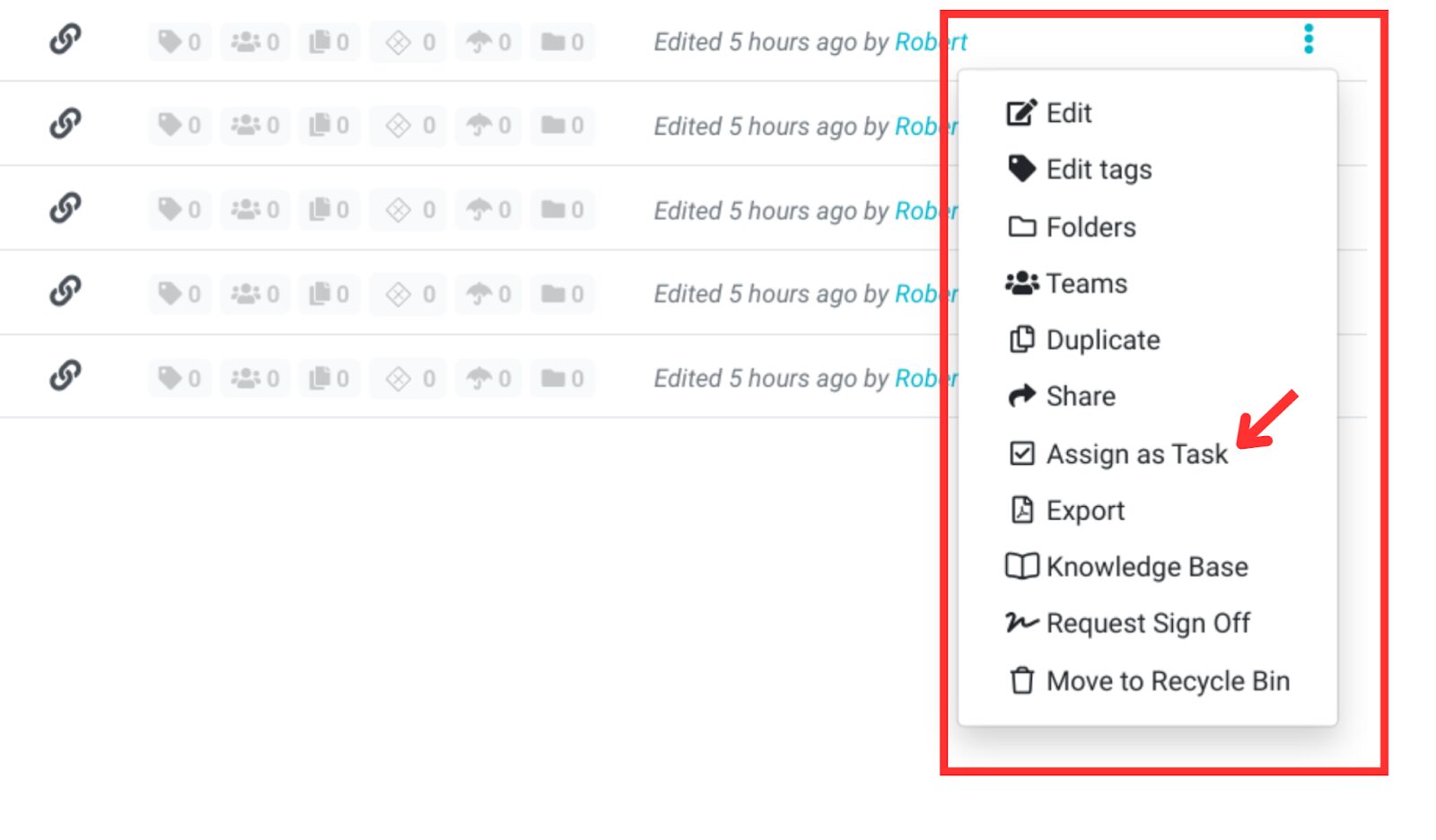
3) Assign Task
- A new window will appear where you can assign the task to an individual employee or an entire team.
- To assign to an employee, simply type their name, and it will appear.
- To assign to a team, click the “+ Assign to Team” button.
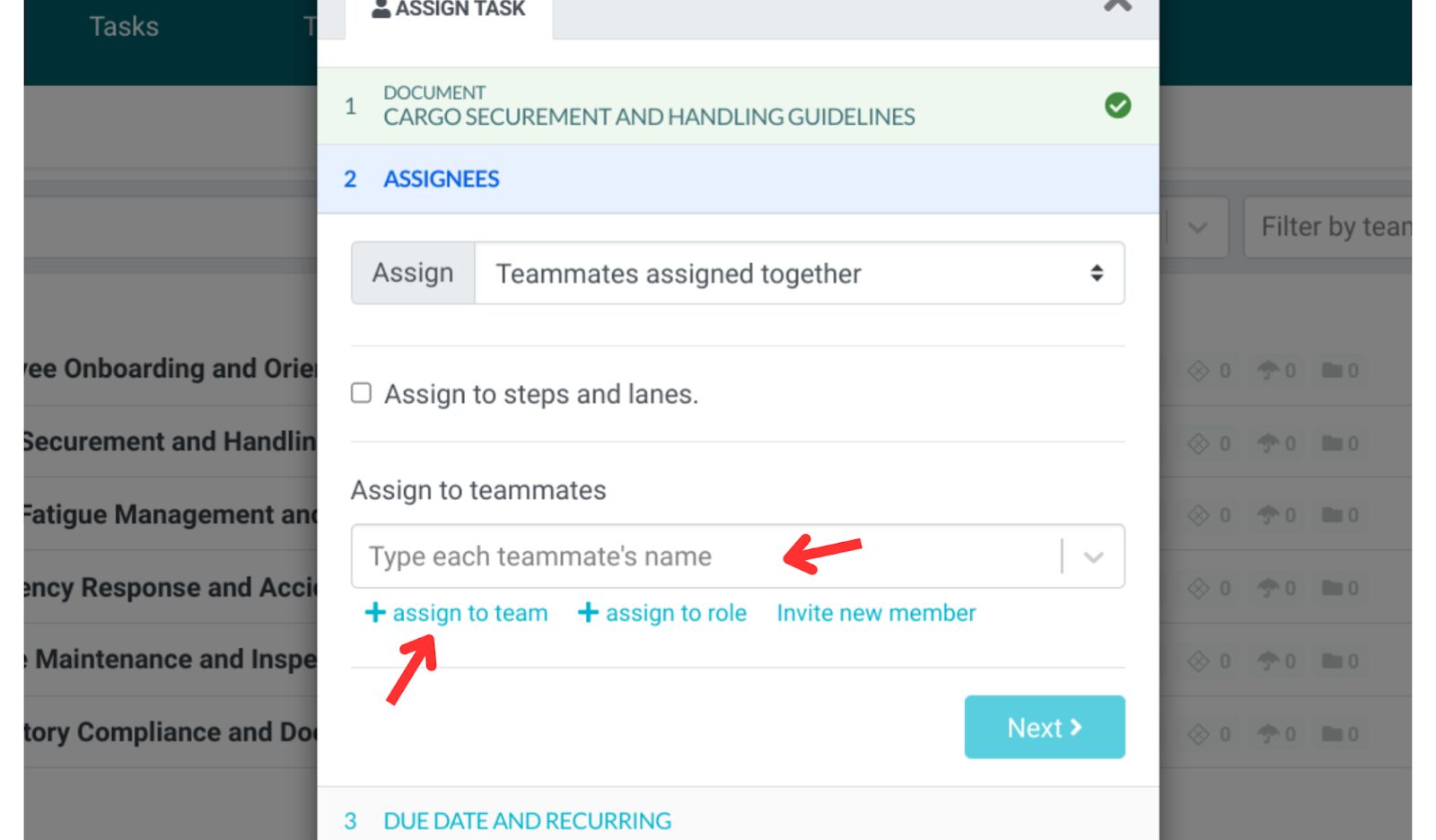
- For this example, assign the task to the Sales and Marketing Team we created earlier.
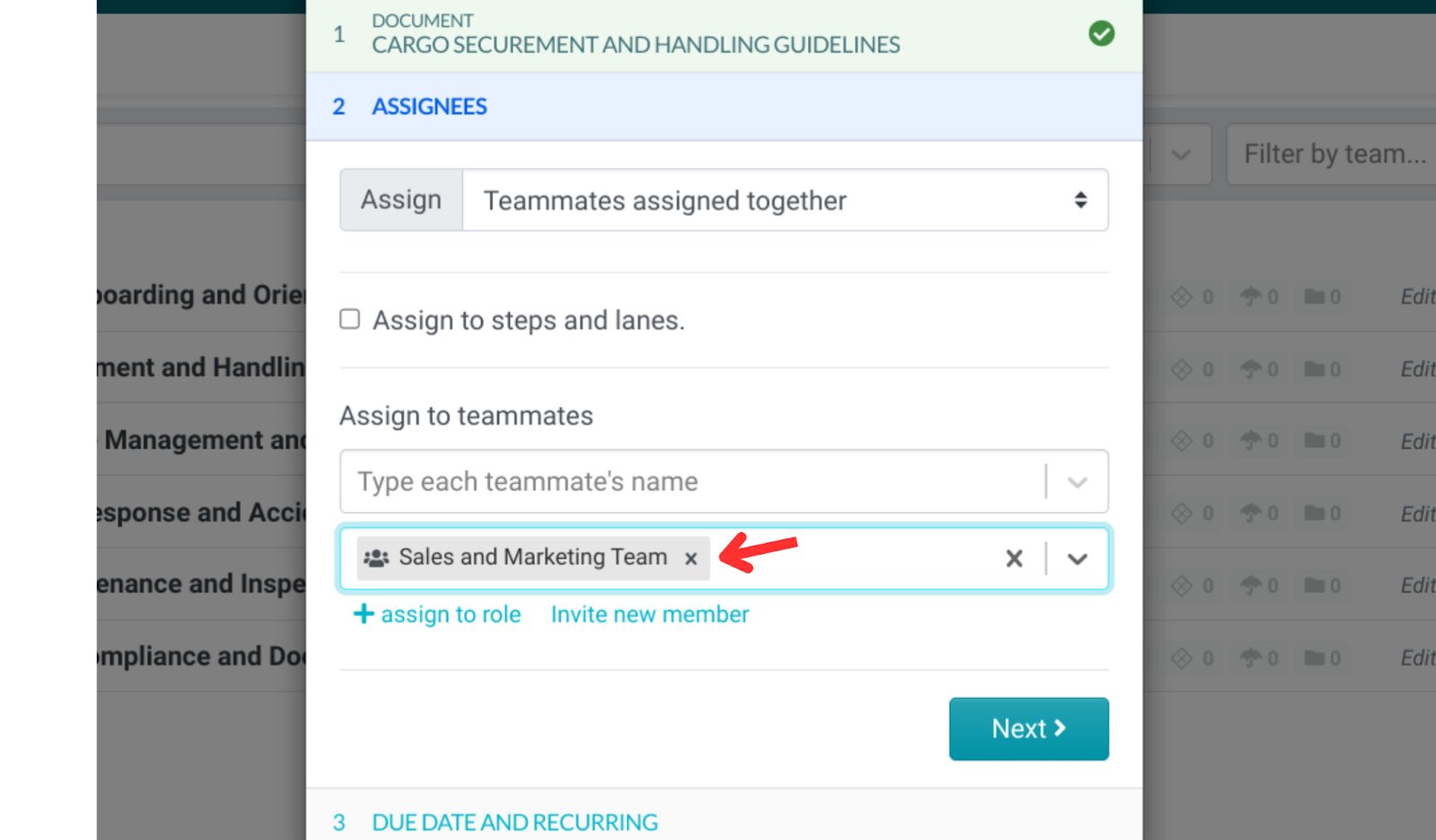
- Click “Next” to proceed.
4) Add Task Details
- In the next window, add more details, including the task title, due date, and recurring frequency.
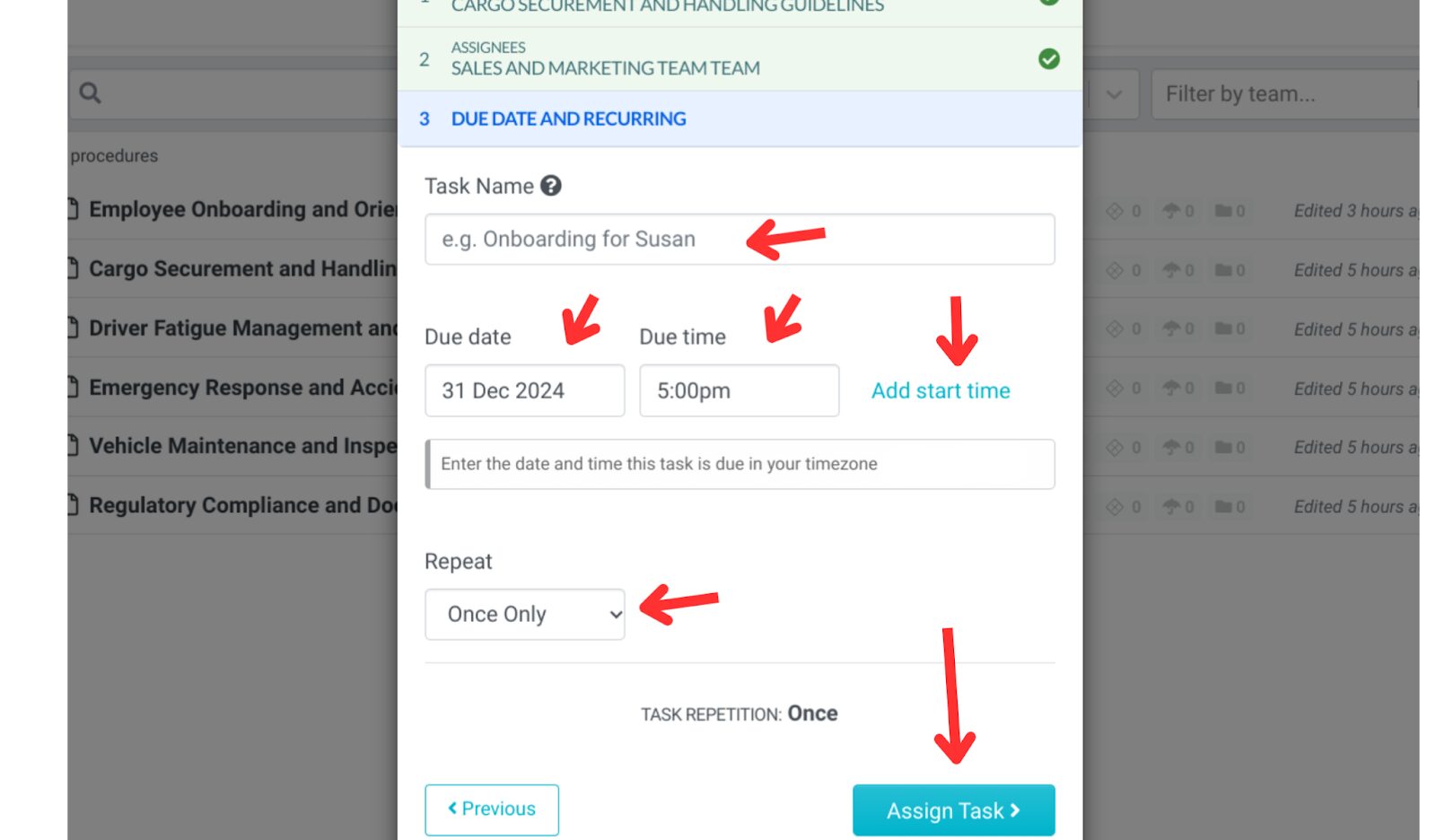
- Once everything looks good, click “Assign Task.”
Just like that, the task is assigned to the team. This process ensures that everyone is clear on their responsibilities and can work efficiently toward completing essential tasks, driving your company’s learning and development initiatives forward.
Turn Existing Procedures and Policies Into a Beautiful Knowledge Base
Having a well-organized knowledge base is a game-changer for any business. It ensures that all employees and clients have instant access to vital information, promoting continuous learning and boosting overall efficiency. With SweetProcess, you can quickly turn existing procedures and policies into an excellent knowledge base.
Here’s how to do so:
1. Navigate to Procedures or Policies
- From the home screen or document page, click the “More” button.
- Select either “Procedures” or “Policies” from the drop-down menu. For this example, we’ll go with Procedures.

2. Select Procedure to Add to Knowledge Base
- You will see a list of all the procedures that are documented in your company.
- Click the three dots in front of the procedure you want to turn into a knowledge base.
- Select “Knowledge Base” from the pop-up window.

3. Update Category
- Choose the knowledge base category you wish to update.
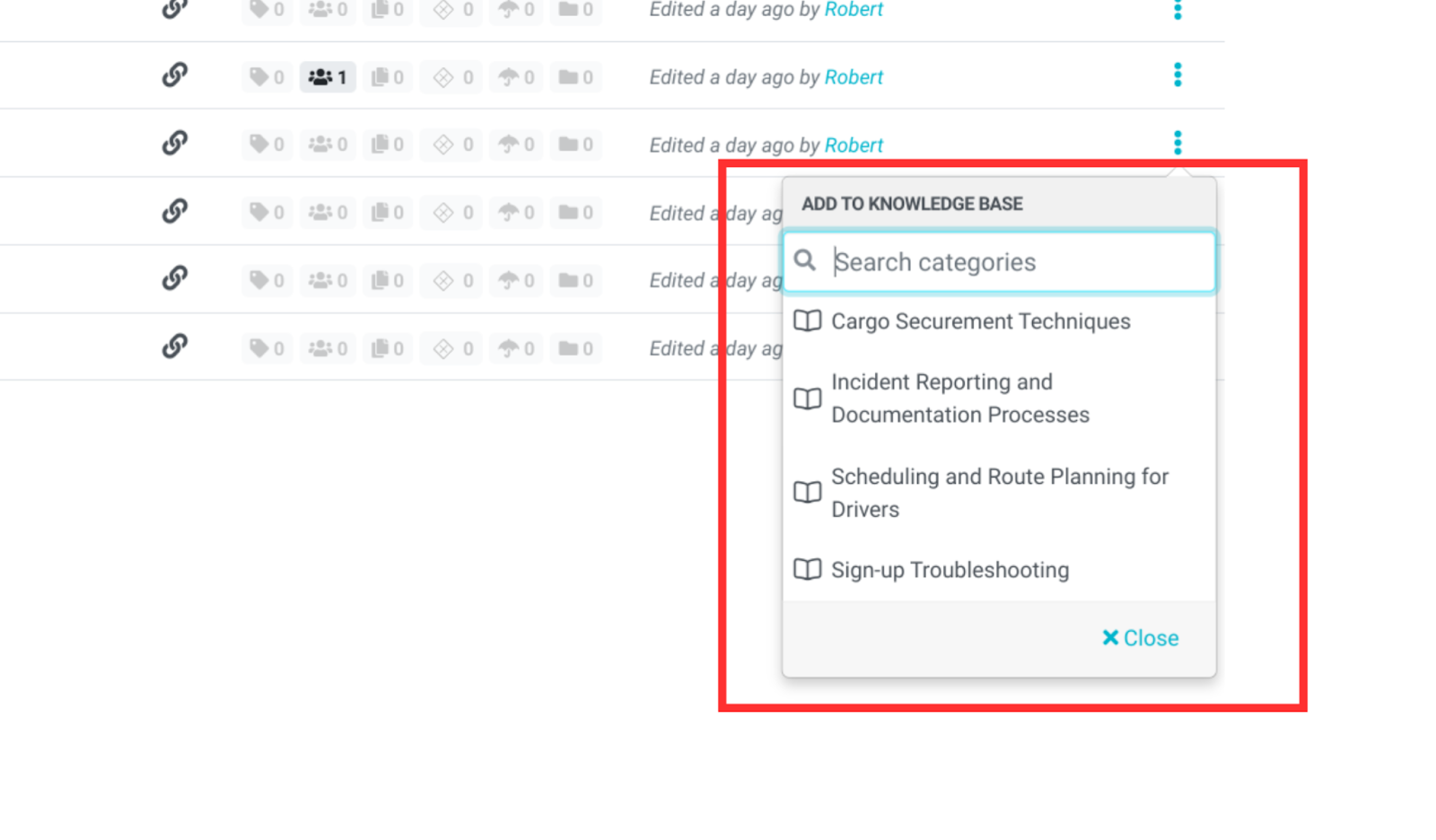
- Click the little “+” in front of the category.
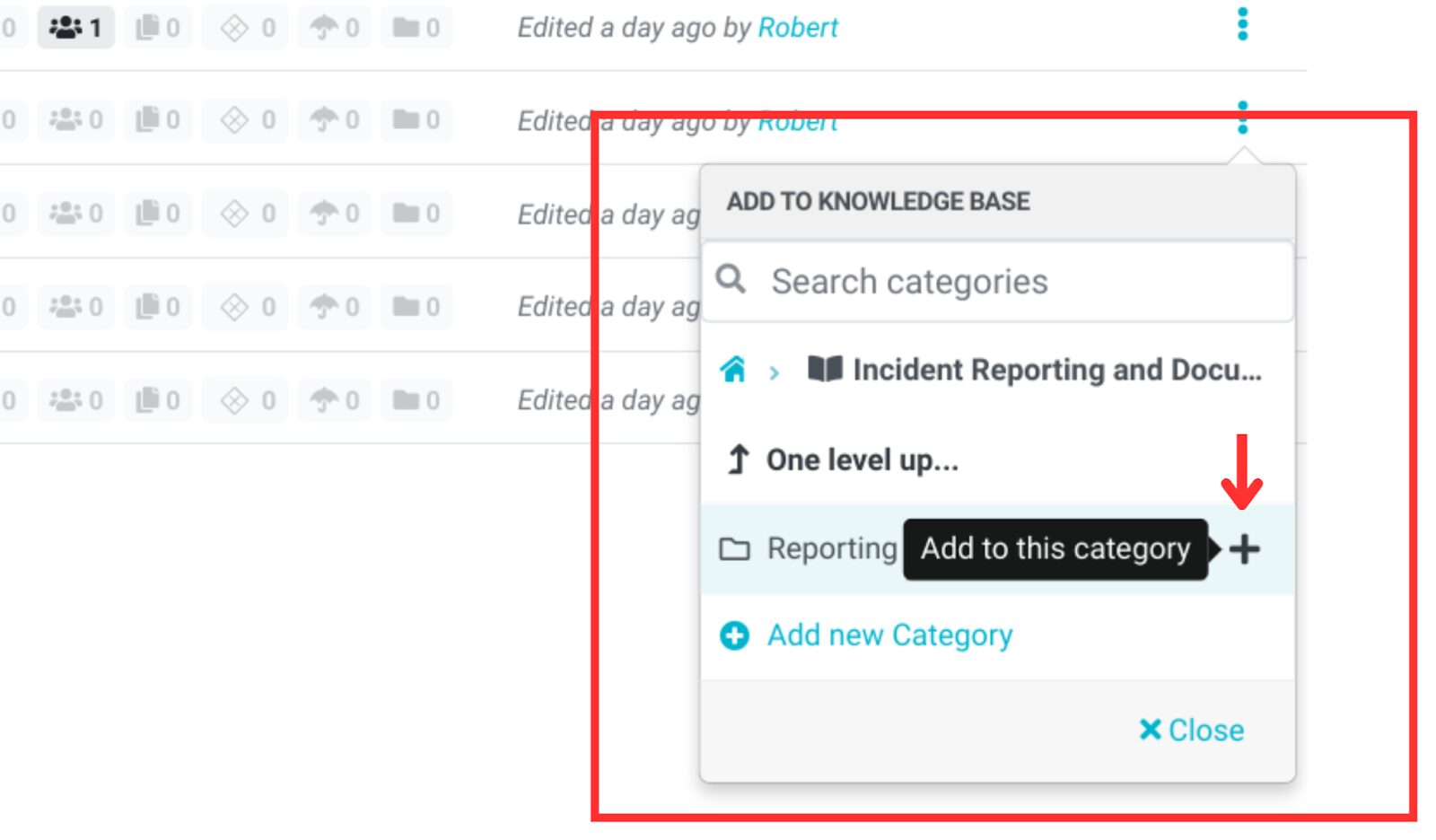
That’s how you successfully convert a procedure into a knowledge base in SweetProcess. This ensures your team always has access to the information they need right when they need it, making your company smarter and more agile.
Manage Procedures, Processes, and Policies
Managing your company’s procedures, processes, and policies is a breeze with SweetProcess. You can easily navigate to the respective pages for your policies, procedures, and processes. To make changes, simply click the three dots next to any entry. This gives you options to delete, edit, and more.
SweetProcess also features SweetAI, allowing you to generate policies, procedures, and processes with just one click after providing a title. This powerful tool saves you time and ensures your documentation is always current and accurate. The result? A continuous learning that drives overall business success.
Take Thimbleberry Financial, for example. They significantly improved their employee onboarding with effective documentation, resulting in a more efficient process. Implementing a similar strategy can enhance your company’s learning and development efforts, ensuring everyone is on the same page and equipped with the necessary information.
Tools for Effective Learning and Development
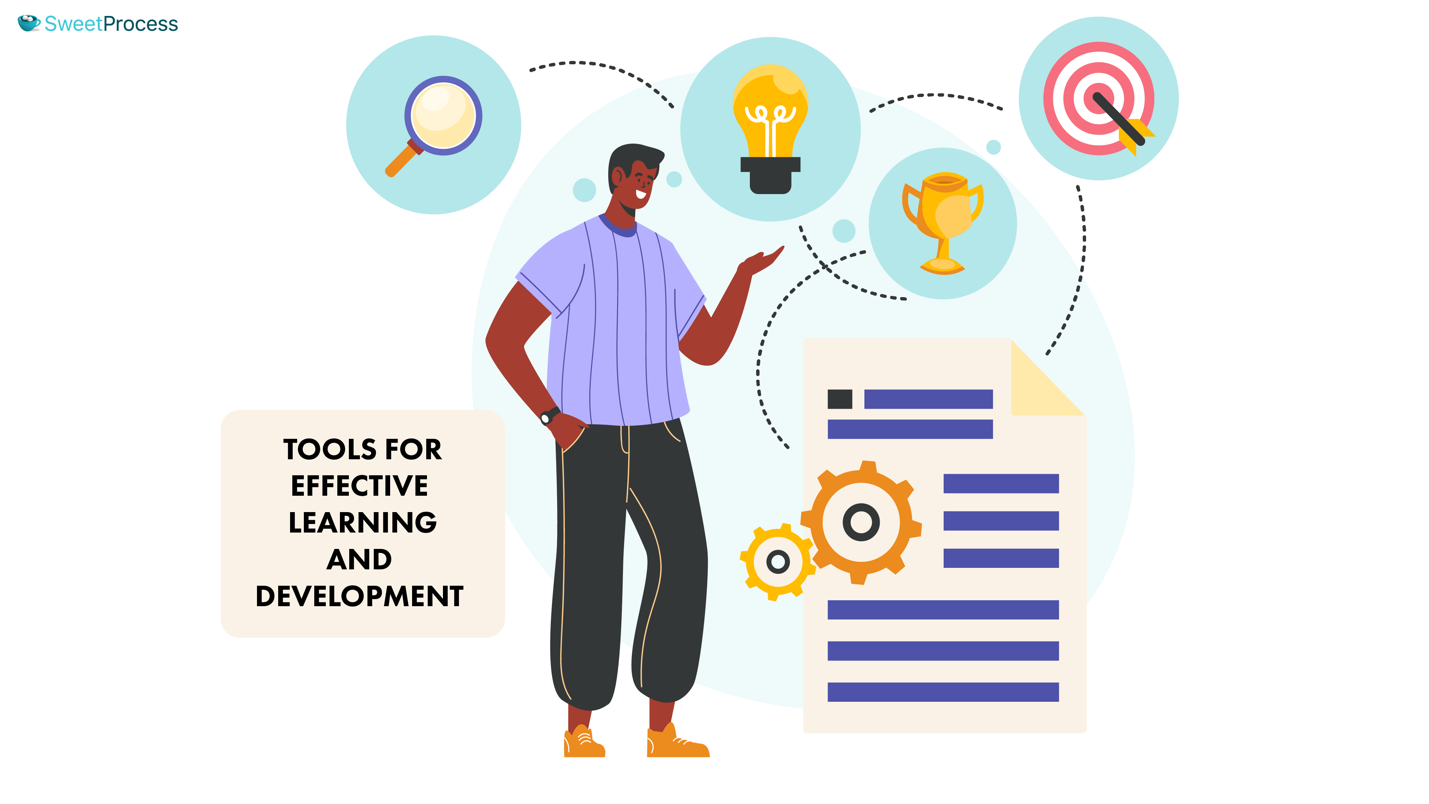
Now that we’ve covered how to manage your organization’s L&D with SweetProcess, let’s look at some essential tools to boost your efforts.
Learning Management Systems (LMS)
A Learning Management System (LMS) is a powerful tool for planning, implementing, and managing learning processes within an organization. Examples include Blackboard Learn, TalentLMS, Moodle LMS, Skilljar, and 360Learning. They help employees access training material, track progress, and engage in continuous development. LMSs are crucial for improving employee skills and performance and promoting a learning culture.
With the LMS market projected to grow from $22 billion in 2023 to $52 billion by 2032, these tools are indispensable for organizational success.
Learning Experience Platforms (LXP)
Another fantastic set of tools is the learning experience platforms (LXPs). These platforms focus on personalizing and enriching the learning experience, helping employees engage with content in a way that suits their learning styles. LXPs like EdCast, Docebo, and Cornerstone OnDemand offer a variety of content, from videos to articles. These tools help drive better performance and long-term retention within organizations.
Talent Academies (Capability Academies)
Next on the list are talent academies, also known as capability academies. These specialized programs develop critical skills within a company. For instance, a tech firm creates an academy to train employees on the latest AI technologies by hiring external experts and leveraging internal resources.
Talent academies provide focused, in-depth learning experiences tailored to meet the organization’s strategic needs.
Digital Adoption Platforms (DAPs)
Digital adoption platforms (DAPs) are tools designed to help employees integrate and use new software and technologies seamlessly. For example, a healthcare organization might use a platform like a step-by-step digital guide to help staff navigate a new patient management system seamlessly. These tools provide real-time, step-by-step assistance, reducing the learning curve and enhancing productivity. DAPs are crucial for a company’s L&D goals as they facilitate seamless software adoption, ensuring employees quickly become proficient with new tools, ultimately boosting efficiency and performance across the organization.
Microlearning Platforms
Microlearning platforms deliver bite-sized, focused learning content designed to fit into employees’ busy schedules. A sales team at a retail company could use platforms like Grovo or EdApp to access quick, targeted lessons on product features or customer service skills. These platforms help employees learn at their own pace without disrupting their workflow. Microlearning is an effective L&D tool, providing just-in-time learning that boosts knowledge retention and enhances performance—a valuable addition to any organization’s learning strategy.
Course Authoring Platforms
Lastly, course authoring platforms allow organizations to create customized training content tailored to their unique needs. Tools like Articulate 360 and Adobe Captivate empower L&D teams to design interactive courses that engage employees in meaningful learning experiences. Let’s say you have a tech company; you could use these platforms to build onboarding courses that teach new hires about internal systems and processes. This approach ensures that training is relevant, scalable, and effective.

Factors Influencing the Success of L&D Strategies
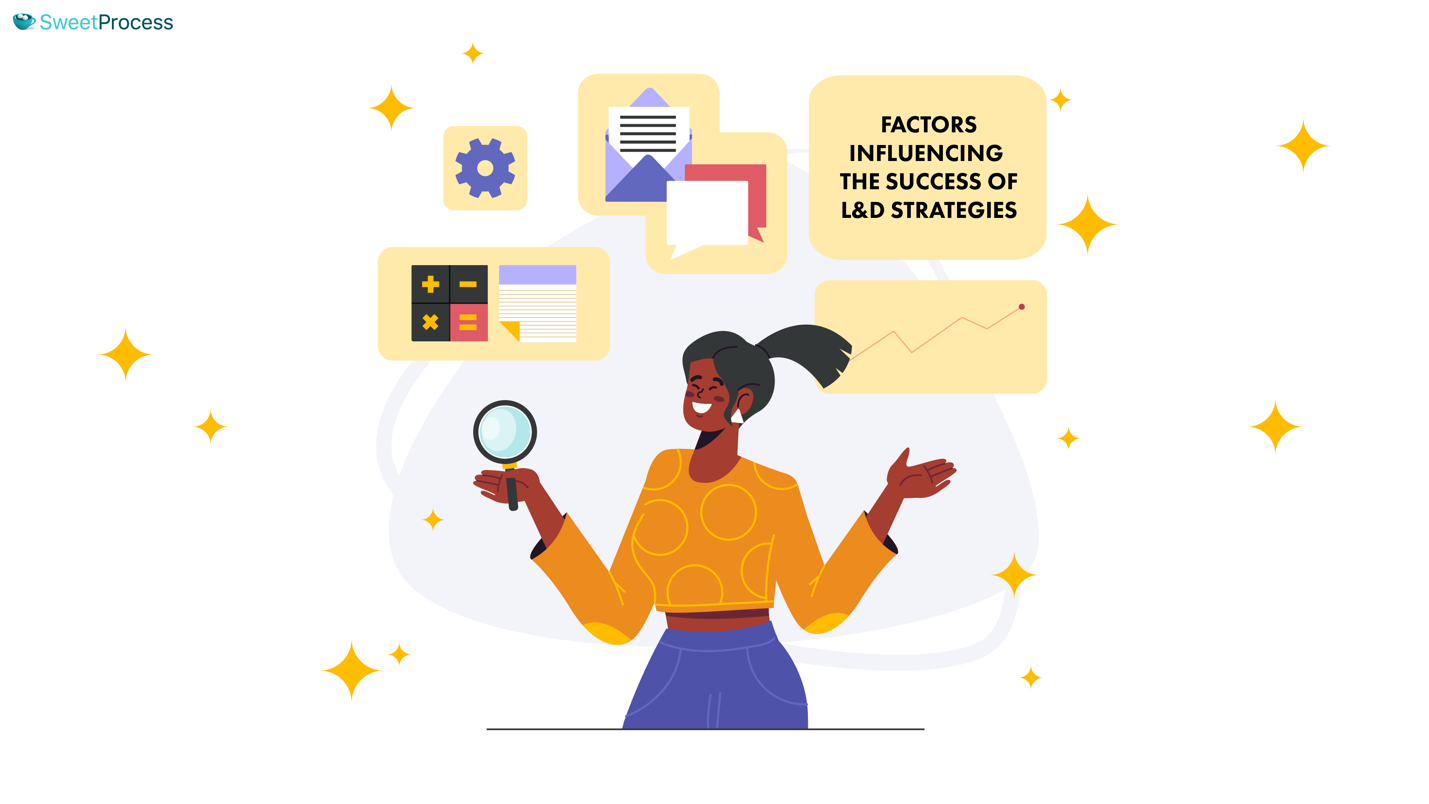
The success of your L&D strategy depends on several key factors. These include:
Goals of the Organization
An organization’s goals are intricately tied to its learning and development strategy. For instance, Google’s commitment to innovation is supported by extensive L&D programs that foster creativity and risk-taking. Aligning L&D initiatives with company goals ensures employees gain skills that reflect the organization’s culture. This way, the company and its employees thrive, creating a win-win situation where organizational goals and personal development go hand in hand.
Workforce Needs and Skill Gaps
L&D programs aren’t just for show—they address immediate and future needs, equipping employees with the necessary skills. Understanding workforce needs and skill gaps is crucial for effective L&D. Industry leaders continually assess their workforce to ensure they remain competitive in an evolving tech landscape. As new technologies emerge, filling these skill gaps becomes vital for staying ahead. This proactive approach helps businesses remain competitive and thrive, ensuring employees are always ready to tackle new challenges.
Return on Investment
Return on investment (ROI) determines how far companies are willing to go with their L&D initiatives. Businesses will invest further in these programs if the training leads to measurable productivity, employee engagement, or retention improvements. For example, companies that see a significant ROI from L&D efforts often expand their programs, knowing that it directly contributes to their bottom line.
Industry Trends
Industry trends are crucial when designing an effective L&D strategy. Progressive organizations are adopting antifragility strategies, creating environments that emphasize growth and adaptability. For instance, Microsoft and LinkedIn found that 79% of leaders understand the need to adapt to rapid technological changes. As industries evolve, organizations aligning their learning programs with these trends can ensure their workforce remains equipped with the right skills, enhancing individual performance and overall business success. This proactive approach helps companies stay ahead in a competitive market.
Budget and Resources
L&D can be a significant investment, especially when considering the costs of tools, software, and professional services. According to Statista, the average expenditure on training for small companies with 100 to 999 employees was around $1,420 per learner in 2023. These expenses can quickly add up, making it essential for businesses to allocate their budget wisely. Balancing quality training with available resources ensures that the investment in L&D delivers value without stretching the company’s finances too thin.
Ready to streamline your L&D efforts without breaking the bank? Start your free trial with SweetProcess today and watch your team’s growth soar!
The Future of Learning and Development
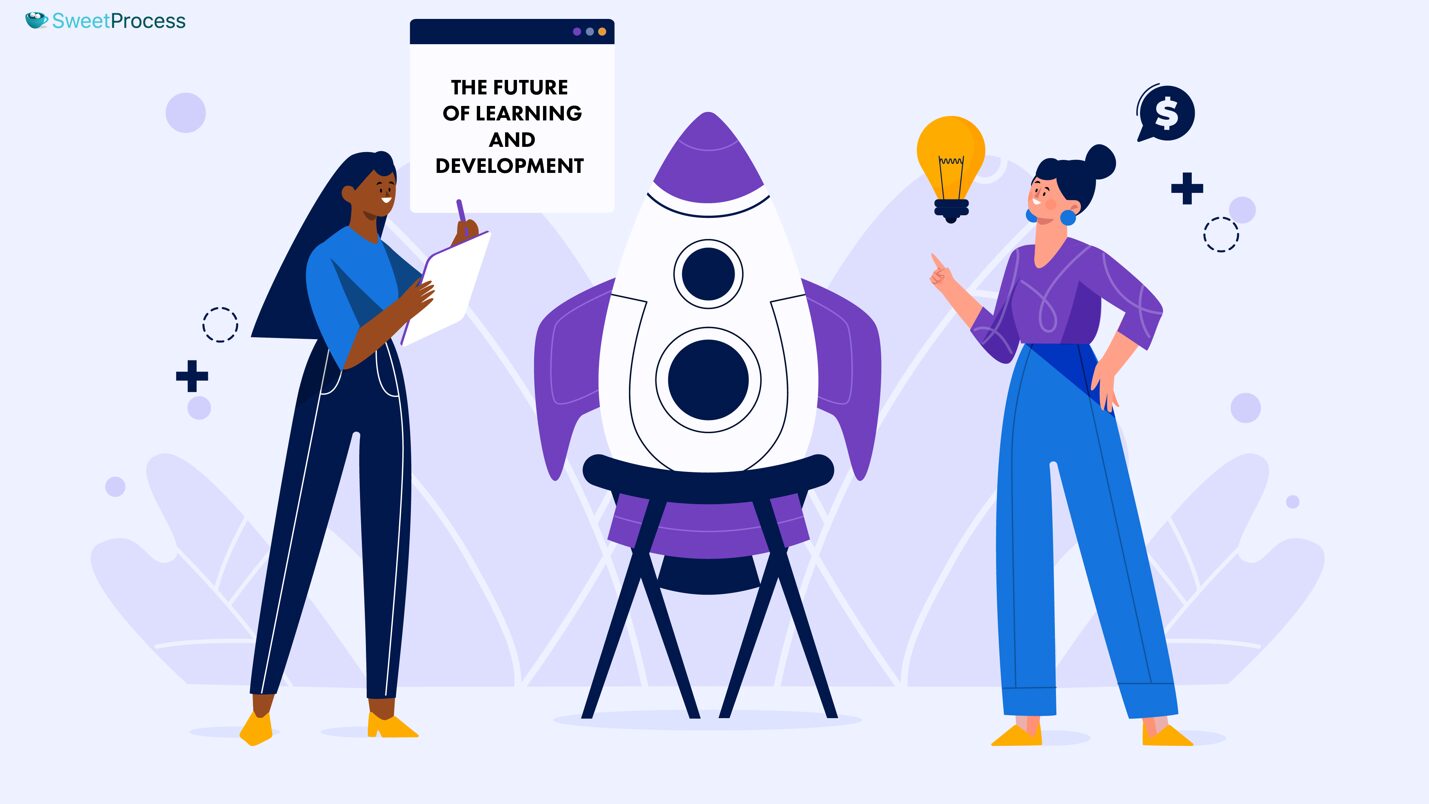
As we’ve seen, L&D is a key factor in business success. Now, let’s examine the future of L&D and how companies can stay ahead.
AI and Automation in Training
AI and automation are transforming the future of L&D. With the global AI market expected to grow at a 36.6% annual rate through 2030, these technologies are reshaping how companies approach training. AI can deliver personalized learning at scale, making training more efficient and accessible. As organizations adopt AI-driven tools, they’ll create more innovative, engaging learning experiences, helping employees grow while driving company success.
Virtual Reality (VR) and Augmented Reality (AR)
Looking ahead, technologies like virtual reality (VR) and augmented reality (AR) are set to transform how we approach learning. Imagine stepping into a training scenario where you’re fully immersed in the experience—this is the power of VR.
A University of Maryland study found that learners using VR-based training scored 40% higher on recall tests than those using traditional computer-based training. This shows how much VR and AR can enhance learning and retention, taking employee development to the next level.
Holistic Well-Being Programs
As L&D continues to evolve, welfare programs are becoming essential. Holistic well-being programs focus on supporting employees’ physical, mental, and emotional health. These initiatives go beyond just work-related skills; they ensure a balanced environment where employees feel valued. Integrating these programs into L&D strategies can help companies create a more engaged and resilient workforce. The result? Employees are better equipped to perform, improving productivity and lower turnover.
Transform Your Learning and Development Program With SweetProcess

As you can see, an effective learning and development (L&D) program is essential for organizations that want to stay ahead in today’s dynamic business landscape. A well-structured L&D strategy helps companies nurture and develop their talent, boost employee skills, and foster a culture of continuous improvement. SweetProcess offers a simple yet powerful way to enhance and modernize your L&D efforts. Its intuitive platform helps businesses centralize their processes and improve documentation and knowledge sharing, all while ensuring that training programs are efficient and impactful.
SweetProcess makes it easy to automate tasks, track employee progress, and create scalable training solutions that meet your organization’s needs. HR managers, team leads, and executives will find that the tool simplifies managing and optimizing L&D programs that drive meaningful results.
Ready to enhance your L&D approach? Start your free 14-day trial of SweetProcess today and see how it can help you create smarter, more effective learning strategies for your business.
